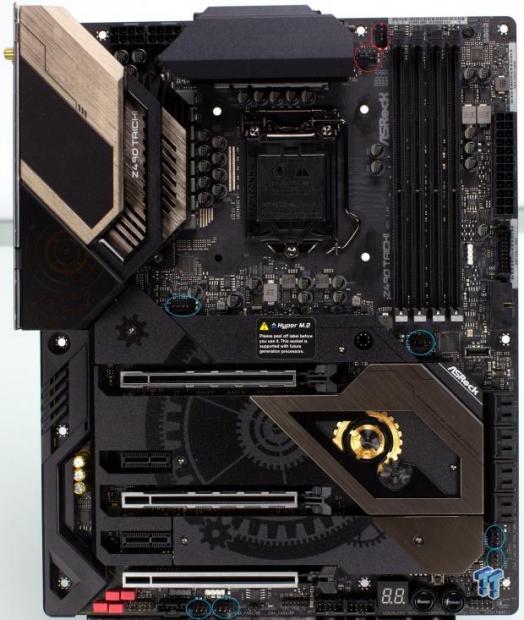
The Bottom Line
Introduction, Specifications, and Pricing
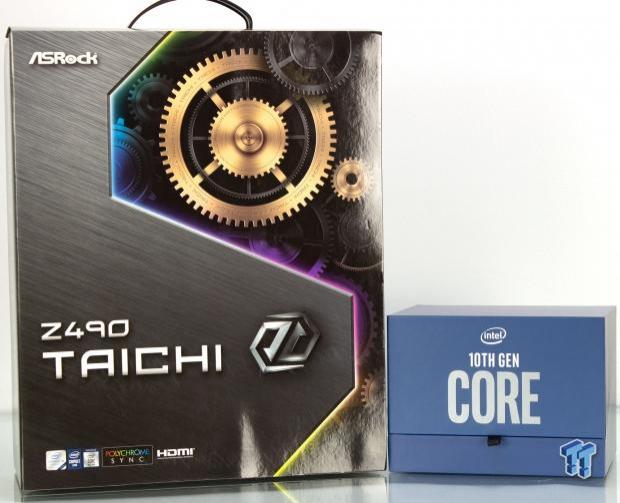
ASRock is the first of our Z490 boards we will be covering for the new Comet Lake desktop series of processors. We are starting with the top dogs from each lineup, and during launch from ASRock, the Taichi is the top dog. Since the launch, ASRock has released the Z490 Aqua, which I look forward to reviewing soon.
The Taichi is a quite subtle entry with needed features, but not a ton of crazy features piled on to inflate the price. ASRock has an engineered simplicity in its Taichi models, which is usually topped by a robust VRM and tuning combo with a feature stack that will make sense for most users, both mainstream and enthusiasts. Although I would say that the Taichi is a more enthusiast-focused product with other models, which we will look at in the following reviews that fill in the more gamer-focused markets.
Specifications
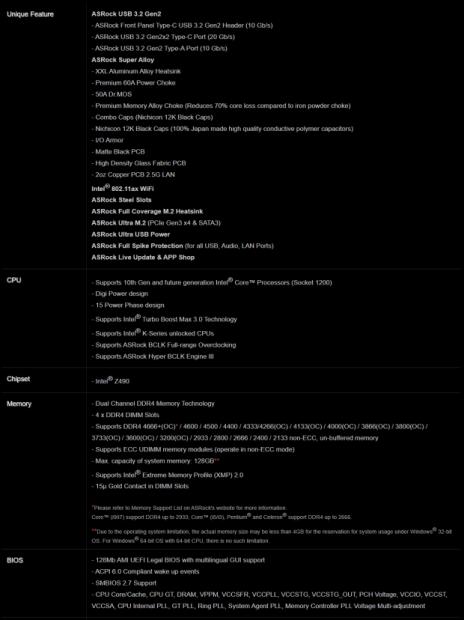
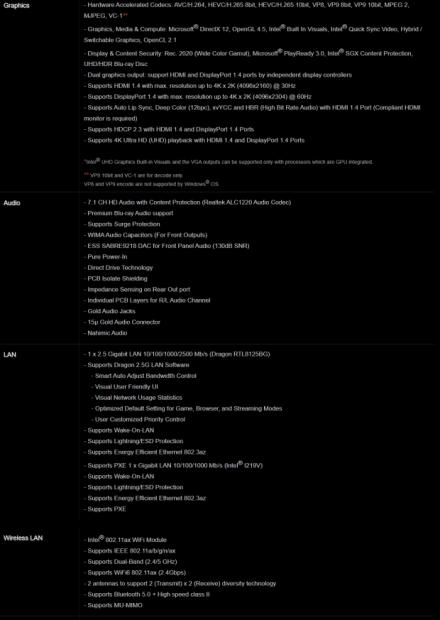
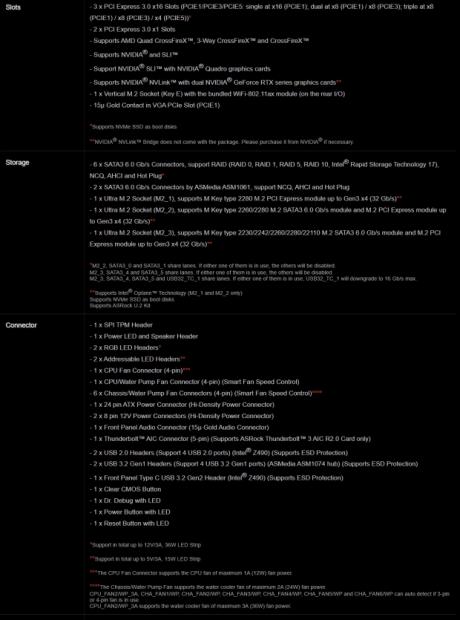
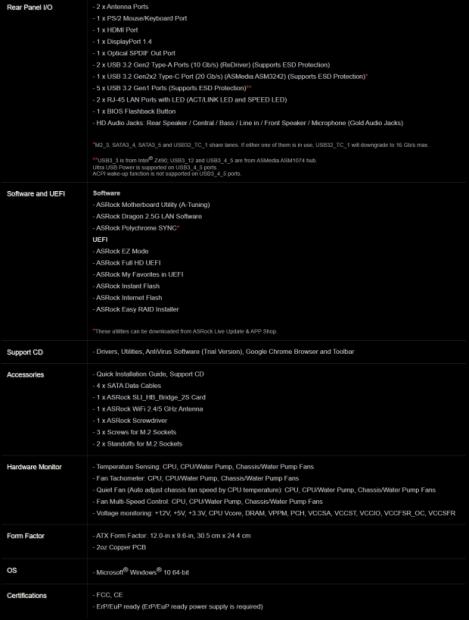
The Taichi supports DDR4 memory and has a claimed overclock capability of 4600MHz+, which of course, means you can overclock and tweak the memory to the limits of your IMC, DIMMs, or even the board.
The Taichi comes with the newest USB 3.2 Gen 2x2, which is via a Type-C port on the rear I/O. This port is capable of up to 20Gb/s speeds, which we will test later in the review. The Taichi also offers the newest Wi-Fi 6/AX and 2.5G Dragon/Realtek LAN along with a 1Gb Intel-powered LAN port.
The VRM cooler is sizable and has three active fans, which we will look it when we take a look at the board.
PCIe support is PCIe 3.0 for Comet Lake, but many board vendors have stated that their boards are built for PCIe 4.0 spec as the next-gen LGA1200 compatible CPU from Intel is rumored to support PCIe 4.0 and should be a drop-in compatible CPU for the Z490 boards.
Pricing
The Z490 Taichi comes to the market at $369.99 at the time of writing. This is quite reasonable for a flagship board, and much less expensive than the top-end offerings from the competition.
With the intro out of the way, let's start digging in to see if the price is justified and if the Taichi can battle on the same level as the boards, which are 2x the cost.

Motherboard Features and Marketing
Here we give space to the motherboard manufacturer to talk about their marketing points, and we assess them and provide our point of view on the claims.
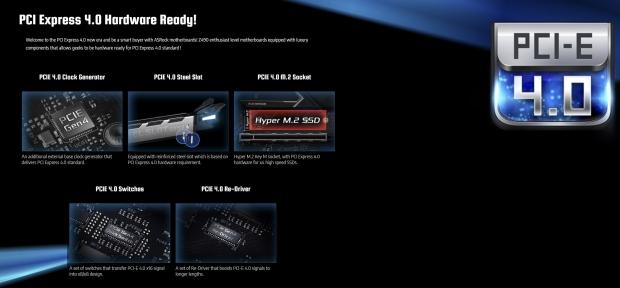
First up is one which has been lauded by most manufacturers, and this is PCIe 4.0 readiness. This is due to several manufacturers confirming that the feature means the board is future CPU ready, and ASRock has M.2, PCIe slots along with the appropriate clock gen, switches, and re-drivers to support full PCIe 4.0 compatibility.
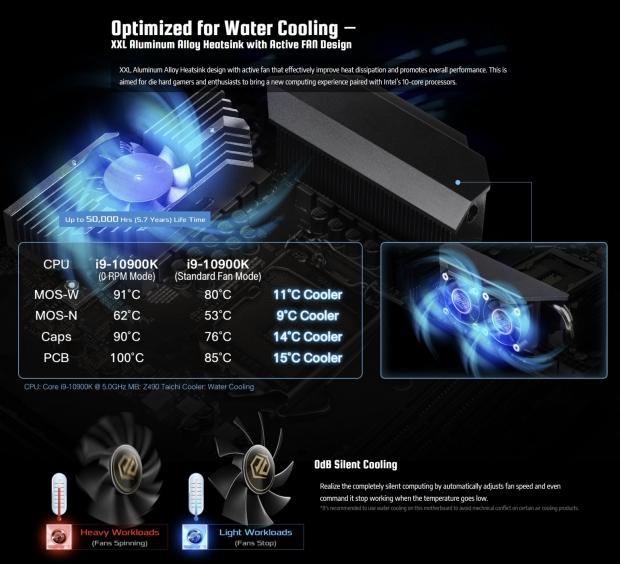
ASRock went all out on the VRM cooling to ensure that no matter the loading scenario, the VRM should stay chilled. The use of components on the VRM and its design means that the beefy heat sink should do a good job alone. Still, ASRock unleashed the ability for users to turn off the fan or adjust the profile to fit their cooling desires while also balancing absolute silence.
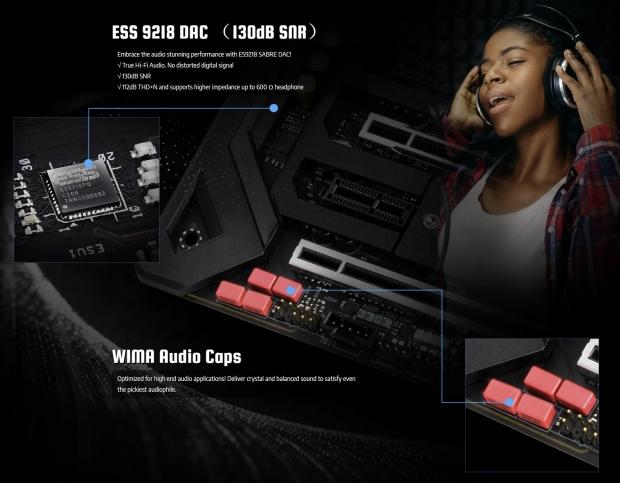
Most higher-end boards utilize the same ALC1220 or a derivative of this, and the only way to differentiate your motherboard is via the supporting components. Things such as the ESS 9218 DAC and WIMA film caps all can play a role in giving the audio a clean signal along with the punch to deliver the best sound quality possible form the codec.
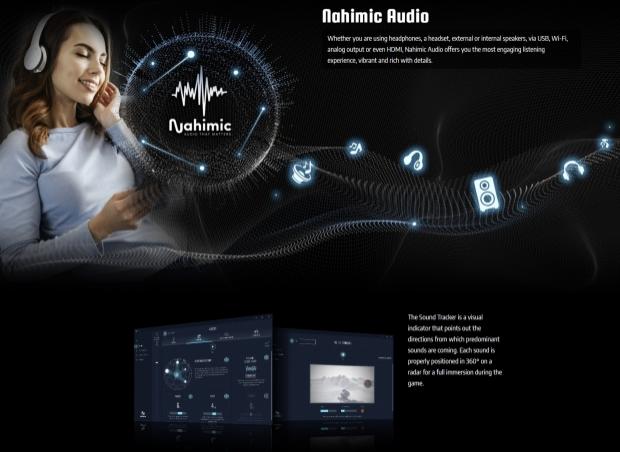
Nahimic is a software layer added to audio solutions to enhance the sound stage. Nahimic is not anything new, but it does, in some scenarios, help make an auditory experience that some have found to be better. I tend to focus more on the raw audio output and tuning it to my needs, but if this is your sort of thing, the Taichi board comes with it.
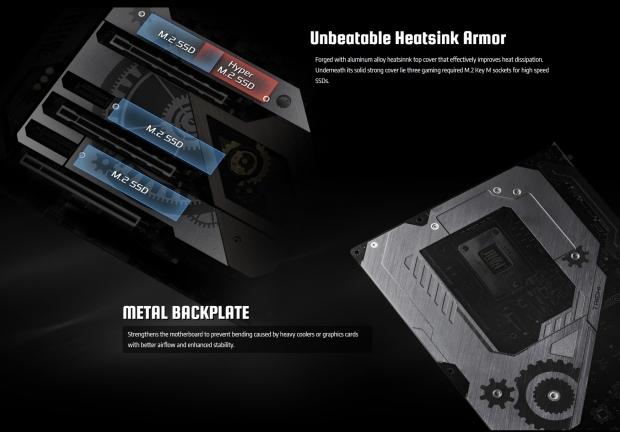
The heat sink armor is one of those things I like that has come along with the aesthetic push for boards over the past generations. The aesthetic is cool, but I more like the stiffening effect that these backplates and embellishments can add in many scenarios.
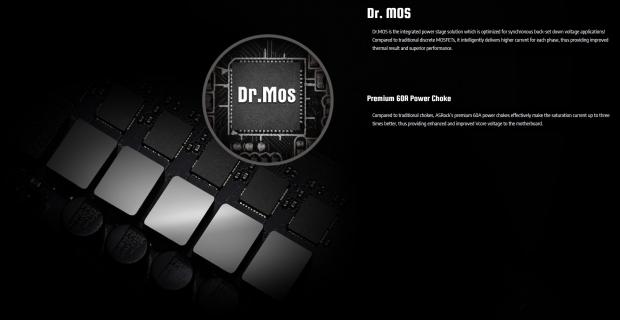
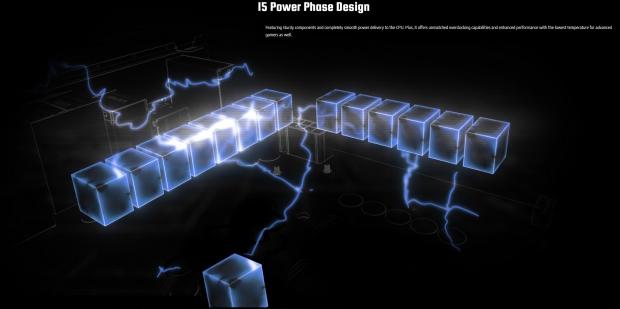
ASRock touts their DR MOS powered 15-phase power design, this is backed by 50A power stages, and 60A rated inductors. We will take a look at the power stages and controller when we tear into the board later in the review.
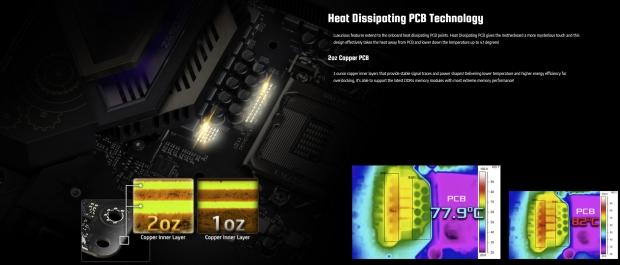
ASRock, as mentioned previously, is hyper-focused on providing features that give the user a benefit. This one surprised me as its something I never considered, but in essence, a PCB is a bunch of layers of copper for traces and power planed separated by PCB substrate material. Copper is an excellent conductor ob power but also heat, and therefore adding raised solder pads form the exposed copper PCB layers can, in essence, work like a small passive cooling grid. The amount of thermal wattage this can dissipate is questionable. Still, when arranged around the power circuitry, it may help keep the areas not in direct heat sink contact a little cooler.
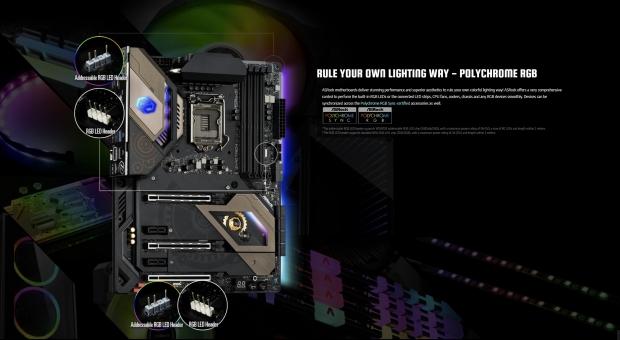
ASRock carries on with its Polychrome RGB solution, and they offer it not only for the onboard LEDs but also dual 12V RGB and 5V ARGB headers. The only real complaint I can share here would be that the Polychrome app, while it is improving, still is not as polished as some other solutions.
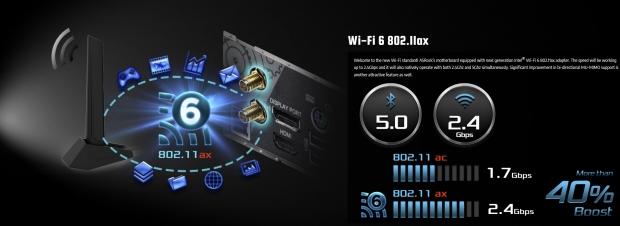
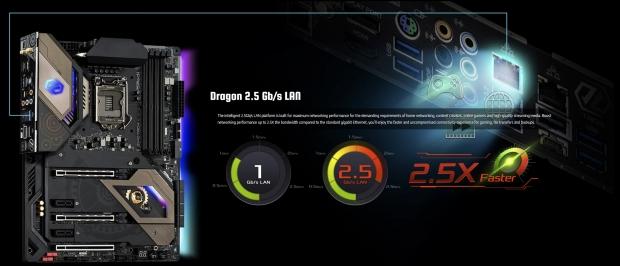
Network connectivity we have Wi-Fi 6/AX for your wireless solution. Wired, we have a 2.5Gb port powered by a Dragon chipset, which is Realtek, but that's another story for another time. There is also a 1Gb LAN port, which is an Intel chipset should your internal network be limited to Gigabit speeds.
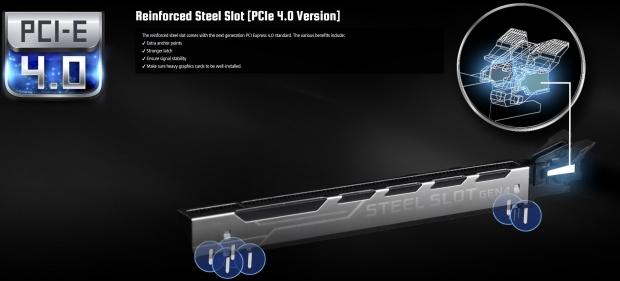
The PCIe slots are steel-reinforced, which has become quite common on motherboards over the last few generations. These are PCIe 4.0 reinforced slots that are claimed to have more solid anchoring helping with more massive GPU seating, and they can help avoid damage to the slot with some of the heavier and thicker GPUs on the market recently.
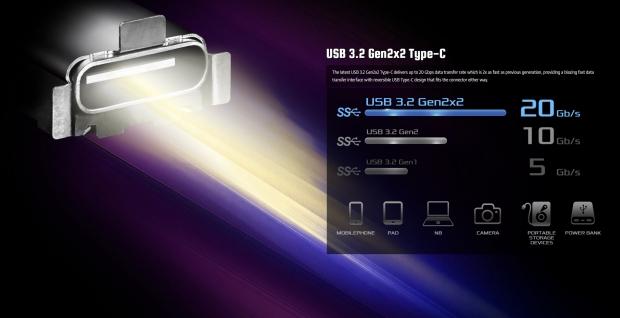
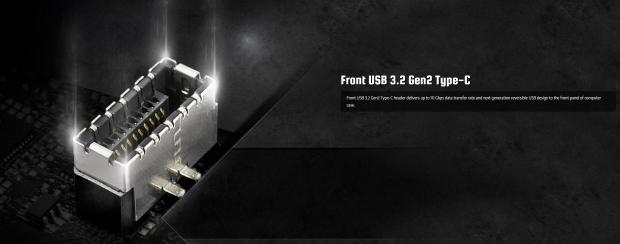
Lastly, we will look at the two USB mentions on the ASRock Z490 Taichi features page. The inclusion of an onboard USB 3.2 Gen 2x2 20Gbps capable port means that you have the newest and fastest USB solution currently available. So new, that there are not many solutions that exist for us to take advantage of the interface. We worked with Western Digital to get hands-on with a new WD Black P50 game drive external SSD to test these new 2x2 ports.
Also, ASRock mentions their onboard USB 3.2 Gen 2 header, which is not that special, as most boards for the past few generations, have been integrating the gen-2 header to match the chassis options now offering the connector.
Packaging and Accessories
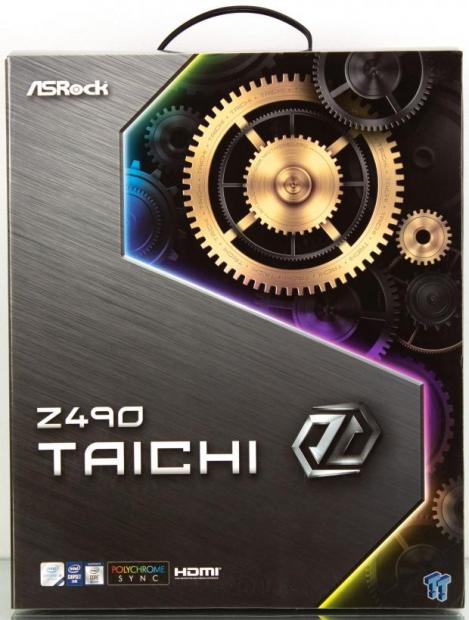
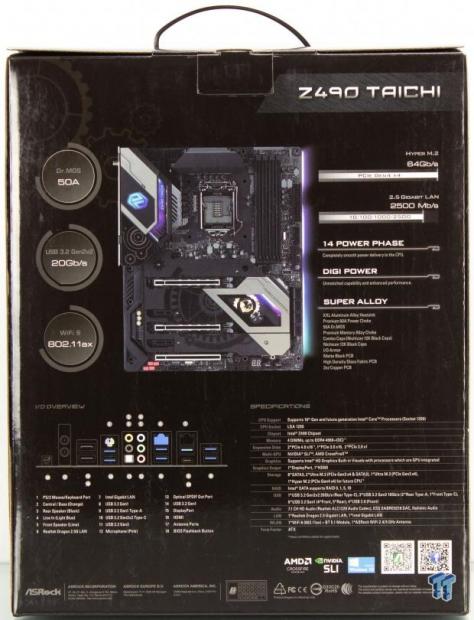
The packaging for the Taichi is familiar for anyone who has seen a Taichi model board in the past. The front of the box is mostly devoid of data besides the product name and a few feature support icons.
The rear of the box is where we can get access to a lot more information. One thing of note is the 14-phase power solution which I believe is the correct entry, as the website lists 15, but I think they are counting the I/O or SA rail into that count, based on the inductor position in the image we showed on the previous page which just seems silly.
Much of the information here, we covered on the previous page, so let's open the front flap and see what it has to share.
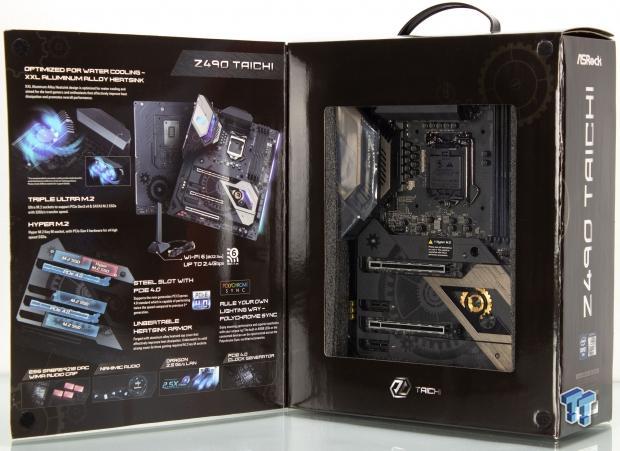
Flipping open the front box flap, we see more of the features we discussed previously on the inner flap. Adjacent to this, we have the opening, which shows the board nestled in the foam inside the box.
Let's open this box up and see what all comes inside.
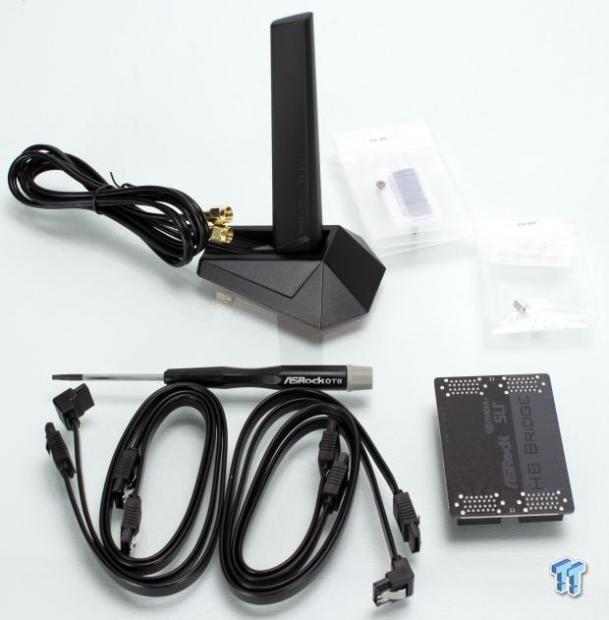
In the accessory pack, it does not have stacks of gear, but it has the things needed to get you up and running, including:
- Wi-Fi Antennae
- 3x M.2 screws and standoffs
- 4x plastic SATA cables
- T8 Torx driver
- HB SLI Bridge
The Torx bit is used to remove the M.2 cooler plates from the board.
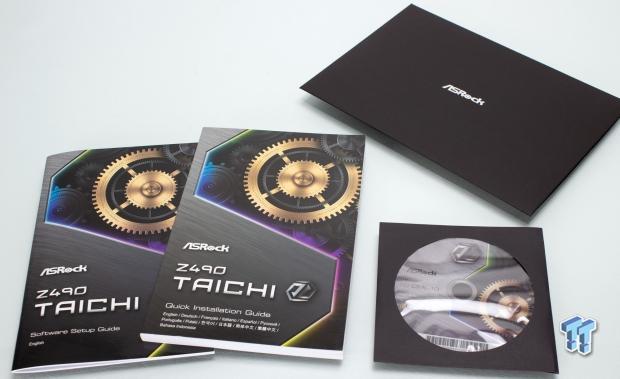
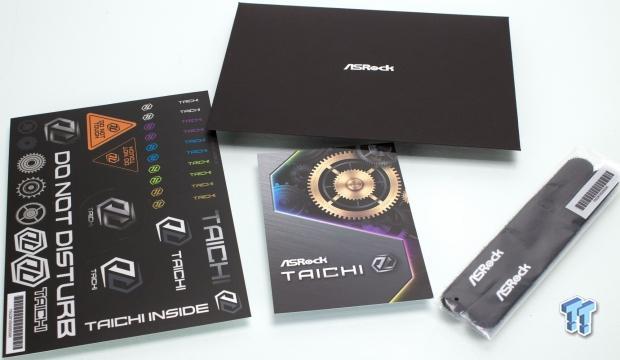
There is also a sleeve in the box which holds the two manuals along with the driver CD. Now is the point where I will bring up that the drivers, whether they are offered on USB as some board manufacturers offer, or DVD is likely going to be older. Your best bet is to go to the webpage for your board and grab the newest offering, as it is very likely going to be newer than what comes in the package.
Inside the sleeve, we find a pamphlet, a pair of Velcro ties, and a sticker sheet.
Now that the accessories are out of the way let's take a look at the board itself.
ASRock Z490 Taichi Overview
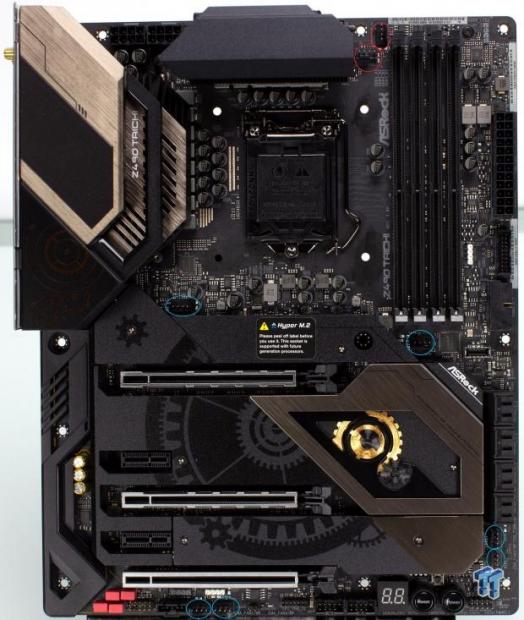
The Z490 Taichi comes with eight total PWM and DC capable fan headers. The two at the top right of the CPU socket that is circled in red are CPU focused with the one closest to the VRM cooler being rated at 1A or 12W. The one next to it is the CPU/WP or water pump capable header rated for up to 3A or 36W of power.
All of the other fan headers are circled in blue and are rated for up to 2A or 24W each. All of these fan headers can automatically detect if you are connecting a 3-pin DC or 4-pin PWM capable fan to them and, therefore, can control either accordingly.
Most of the significant components are metal and work as heat sinks, while the I/O cover and the audio covering running down the I/O shield side of the board is plastic.
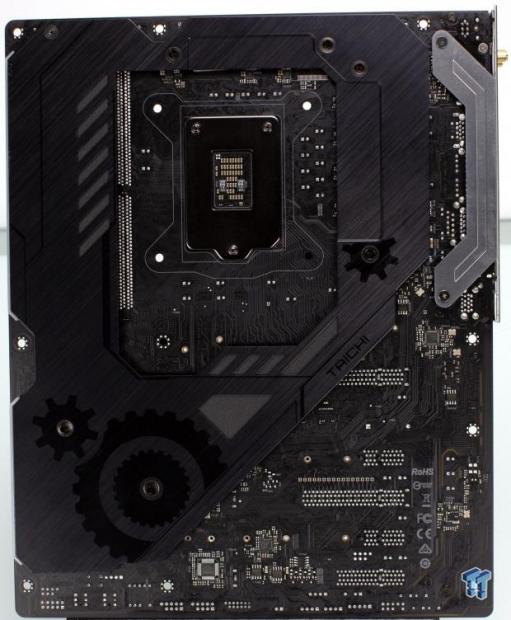
The rear of the Taichi is mostly covered by the backplate, but ASRock opted for an angular solution which omits to cover a large portion of the lower part of the board. We can see some active cooling pads in place on the rear of the VRM based on the depressions in the metal and the small hint of a thermal pad peeking out from the edge. There is plenty of room for any CPU cooler backplate solution to fit without issue.
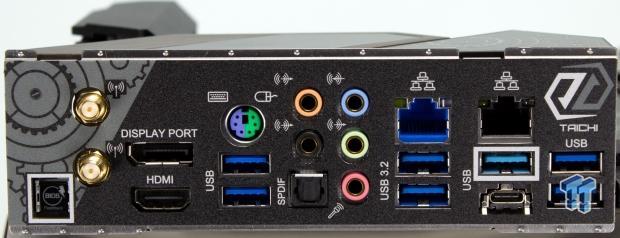
The I/O on the Taichi is well-appointed as follows:
- BIOS Flashback Button
- Wi-Fi Antennae Connectors
- DisplayPort and HDMI ports
- Combo PS/2 port
- 5x USB 3.2 Gen 1 Type-A ports
- 2x USB 3.2 Gen 2 Type-A ports
- USB 3.2 Gen 2x2 Type-C port
- Analog 7.1ch audio with gold connectors
- Optical SPDIF port
- 2.5Gb RJ45 Dragon LAN port
- 1Gb RJ45 Intel LAN port
The coloring of the USB ports is usually a visual indicator of what generation the ports are. However, in the case of the Taichi, we find that the darker blue ports below the blue LAN port are the Gen units. The other dark blue ports are Gen 1 along with the lighter blue Type-A port, which is also Gen 1. Then we have the Type-C, which is 2x2. The issue goes further as the I/O shield does not help delineate which ports are which as they also do not designate which LAN port is 2.5G, but luckily the blue one is the right one in this case.
This identification oversight is a minor annoyance, but one that may be troublesome if you are trying to match the correct speed peripheral with the higher speed ports, you will likely end up referencing the manual a bit to get your installation sorted.
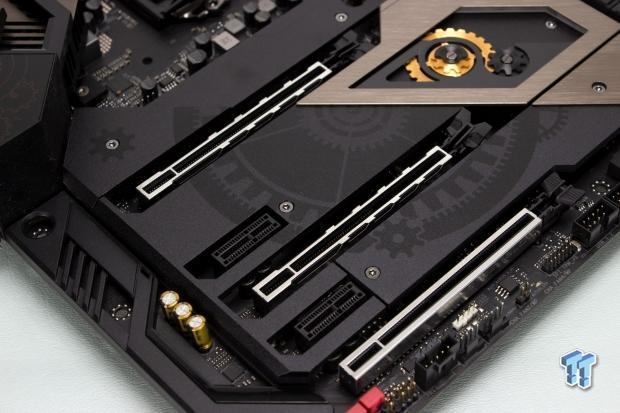
The slot arrangement is triple x16 mechanical, and two x1 slots. The triple x16 slots can run up to three cards at x8/x8/x4. The bottom x16 length slot is likely fed by the PCH, and therefore is a PCIe SSD is installed here; it will share the DMI link from the PCH to the CPU.
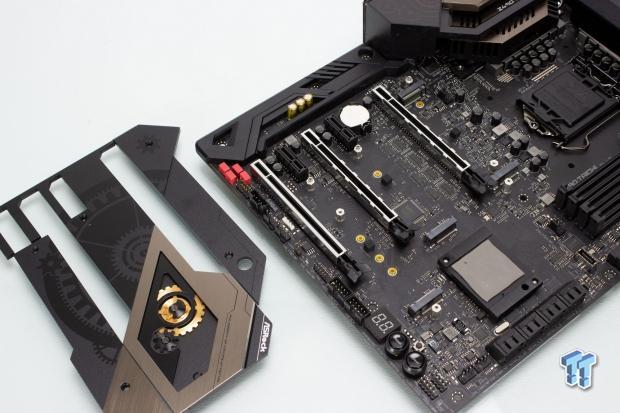
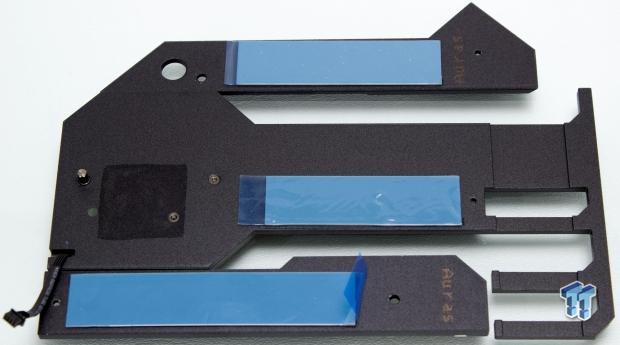
Popping the lower covers off of the board, and we see that the cover is mostly metal. This shielding cover assists as an additional heat sink surface area for the PCH along with cooling the M.2 devices.
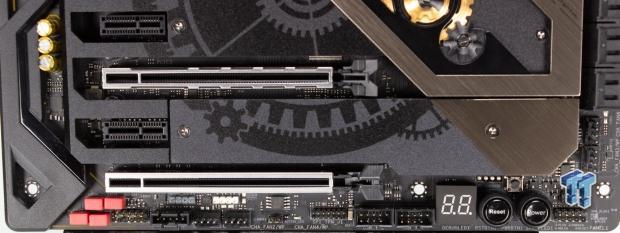
The lower edge of the board carries various connectivity as follows:
- Front panel audio header
- Thunderbolt header
- 12V RGB and 5V ARGB headers
- 2x Fan/pump 2A fan headers
- Clear CMOS Jumper
- TPM module header
- 2x USB 2.0 headers
- Hex post code LED display
- Power Button
- Reset Button
- Clear CMOS Button
- Front panel and speaker header
I do like that ASRock gives you an option for a clear CMOS header, which you can then repurpose a remote switch to activate should the board be used in an OC environment where the onboard button may not be easily accessible.

The 24-pin side of the board hosts various connectivity as follows:
- 2x Fan/pump 2A fan headers
- 8x SATA 6Gb ports (6x PCH/2x ASMedia ASM1061)
- USB 3.2 Gen 2 header
- 2x USB 3.2 Gen 1 headers
- 24-pin main ATX connector
- 5V ARGB header
I do like that ASRock varied connectivity such as the 20-pin USB 3.2 Gen 1 header with one being vertical and one being flat against the board. The SATA ports, although not color differentiated, are running from two different controllers. The bottom two ports are the ones that are fed by the ASMedia controller.
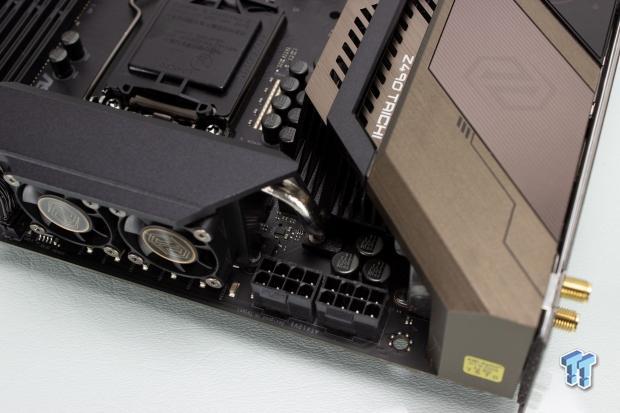
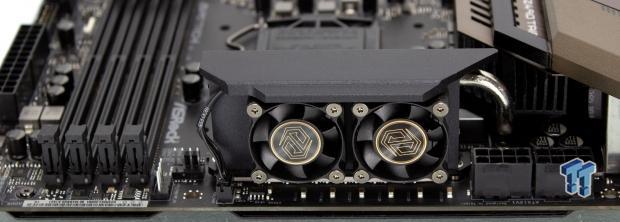
The Taichi comes equipped with dual 8-pin EPS connectors. This should ensure you have plenty of amperage on tap for even the most extreme overclocks of the new 10900K CPU. The VRM has three fans, and here we see two deployed at the top VRM, which is usually the one that received the least amount of airflow. The other fan we will take a look at next as it is in the other portion of the VRM cooling.
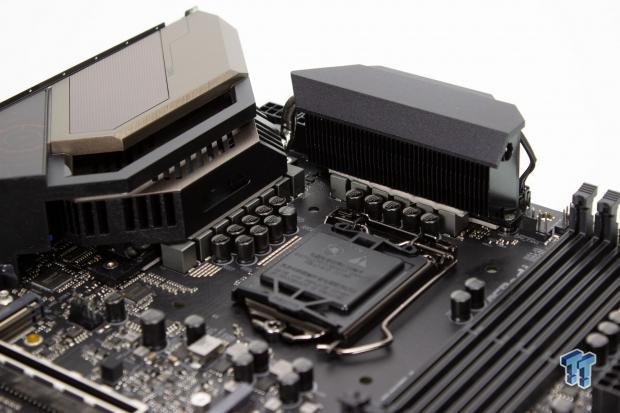
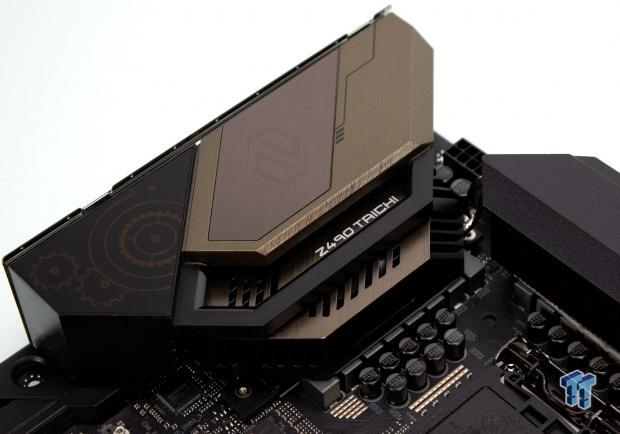
Here we can see the socket area and the VRM cooling surrounding it. ASRock lists that for best compatibility, liquid cooling is advised as some air heat sinks can have interference issues with the VRM solution, and with how big the coolers are, it may be an issue, but I think most won't be a problem. However, with the amount of heat, we found that the 10900K can pump out; it would be advised to run liquid cooling for the best possible performance of the TVB.
Looking at the top of the I/O shield cover, we can also see the slits in the VRm heat sink cover, which is where the 3rd fan can ingest air to assist the VRM at removing heat.
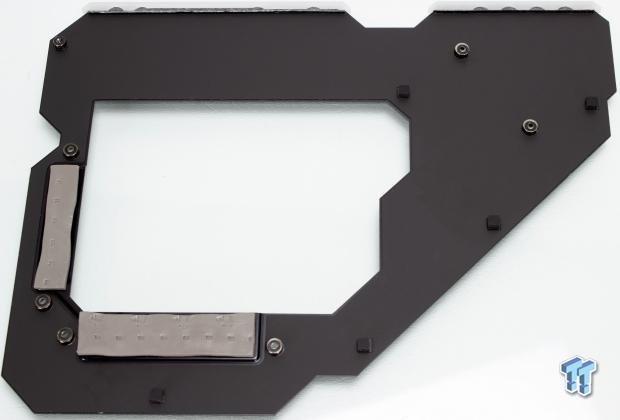
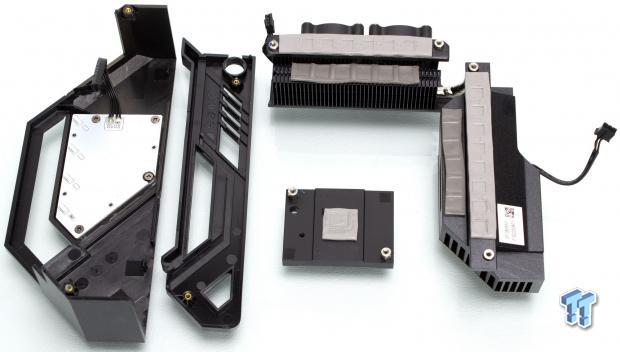
Here, we removed the backplate and the cooling fixtures from the Taichi. We see the two thermal pads, as mentioned previously, that help sink heat away from the rear of the VRM section to offer a little extra nudge of cooling performance.
Next, we see the VRM and PCH coolers along with the I/O area and audio section covers. We can see the fan connectors from both VRM cooler potions. We can see by the impressions in the thermal pads that the VRM is making excellent contact with the cooling solution.
Now, I think it's about time we move on to the PCB and circuit analysis of the Z490 Taichi.
PCB and Circuit Analysis
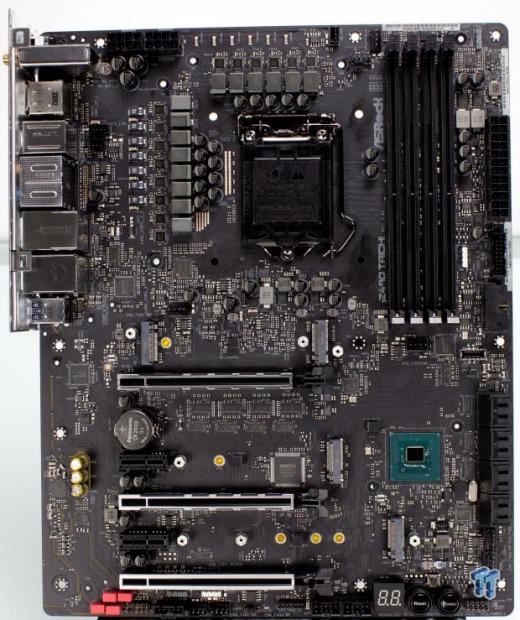
Pulling all of the previously viewed cooling and other shielding features leaves us with the bare Taichi motherboard, as you can see here. A lot is going on here, and we will cover some of the high-level components in the following images.
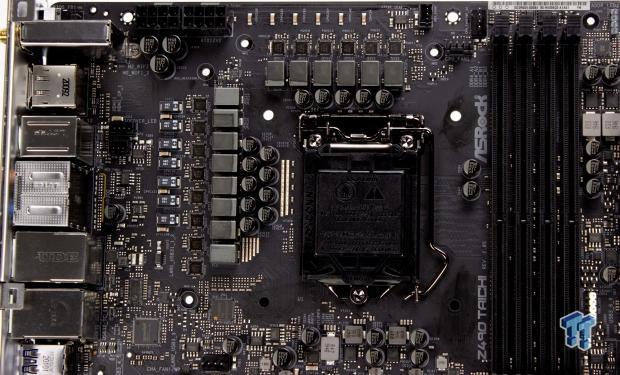
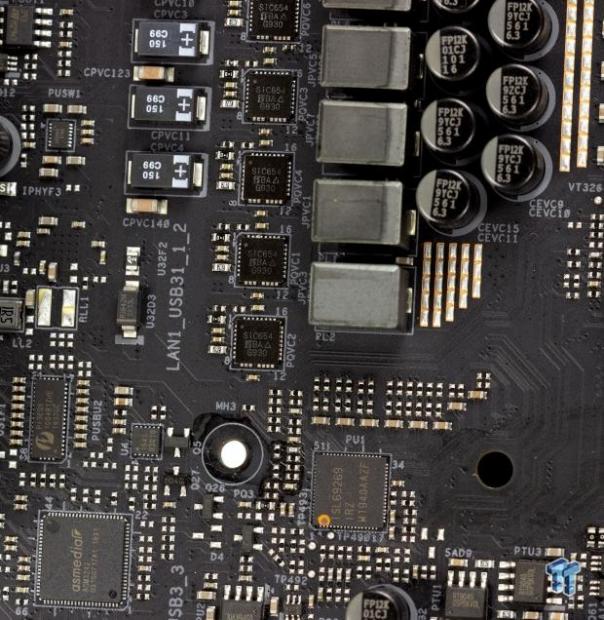
The VRM of the Z490 Taichi is a 12+2 design powered by an Intersil ISL69269. The CPU phases are 50A SiC654 Vishay units and are using ISL6617 smart doublers. This is not nearly as powerful of a VRM solution as we have seen on some costly boards, but with a little math, I think we can safely say that there is plenty of room in this VRM for even XOC usage as it is fitted.
To the lower left of the VRM section, we spy the ASMedia ASM3242, which is the USB 3.2 Gen 2x2 controller enabling the 20Gb capable USB Type-C port on the rear.
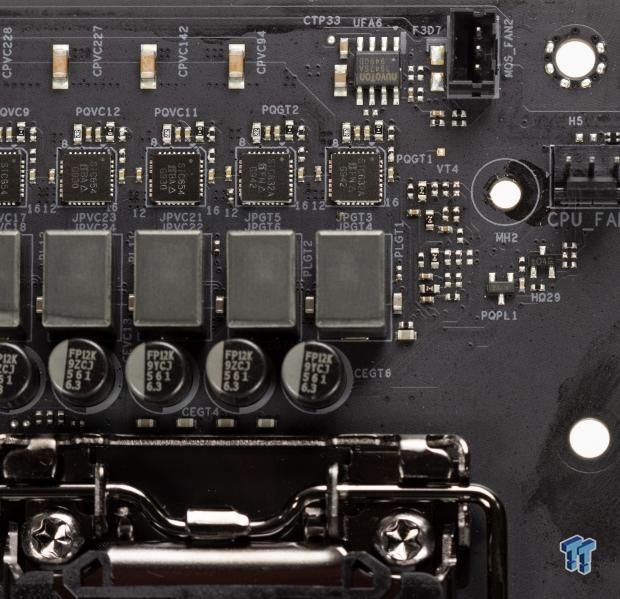
Here we see the two GT or iGPU phases, which are powered by SiC632A, which are also 50A power stages from Vishay, but these are used to drive the UHD 630 on the Intel CPU.
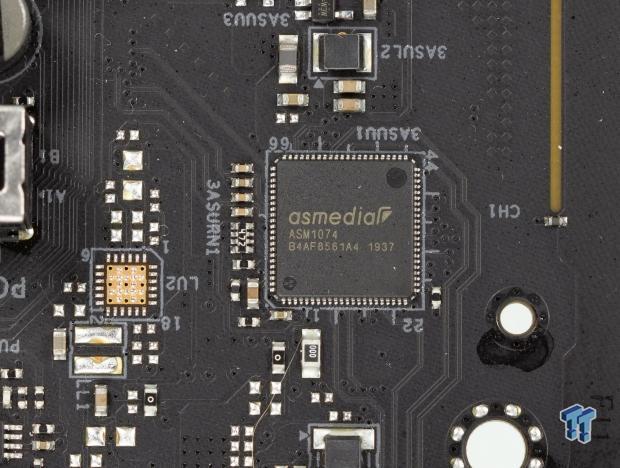
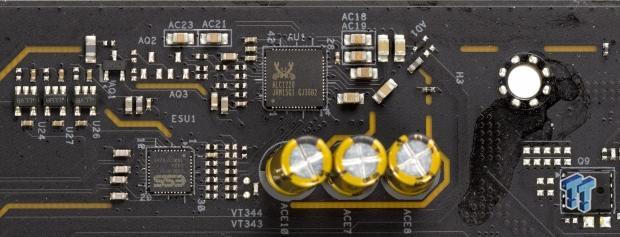
Next up, we have the ASMedia ASM1074which is the USB Superspeed or USB 3.2 Gen 1 controller for the 5Gb USB ports.
The audio solution is the ever-popular ALC1220 from Realtek, and it is backed by an ESS DAC. There are even large electrolytic Nichicon caps along with high-end WIMA film capacitors (not shown in image) in the audio solution.
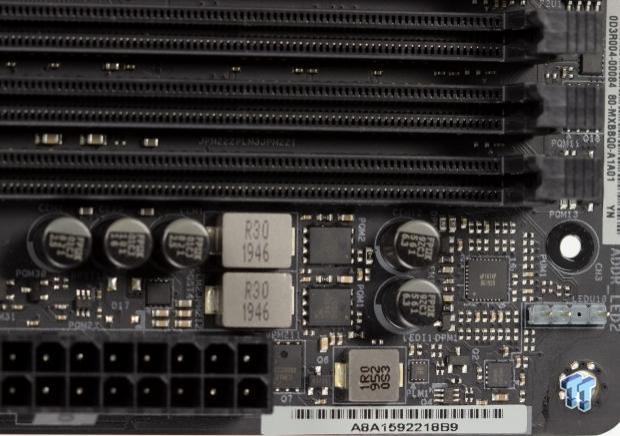
Here we see the memory VRM, which is a dual-phase solution comprised of Sinopower dual N-channel MOSFETs model number SM7341EH. The PWM controller is a uP1674P to push the double memory phases.
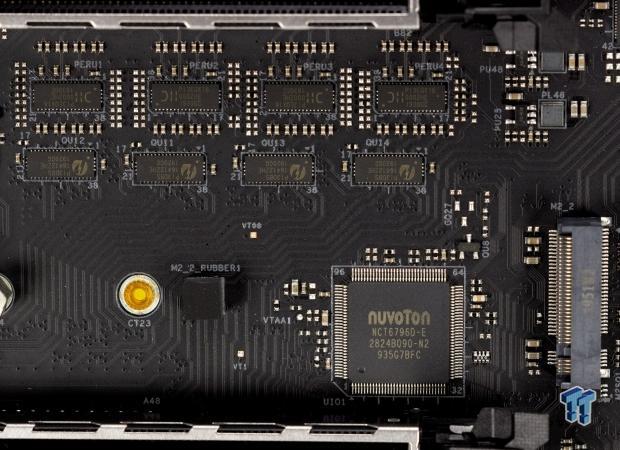
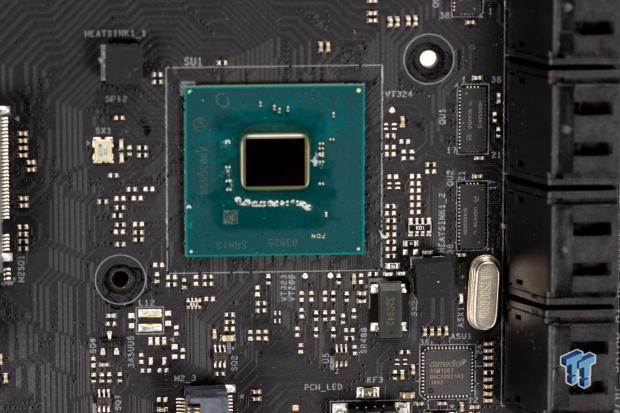
Midboard, we have the SuperIO chip, the Nuvotron NCT6796D-E. Above the SuperIO, we have the PCIe 4 capable redrivers (P13EQX16) and P13DBS for the handling of the exchanging of lanes depending upon the slot population.
We also have the PCH at the lower right, and below that, to the right, we have the ASM1061, which is used for the two extra SATA 6Gb ports mentioned previously.
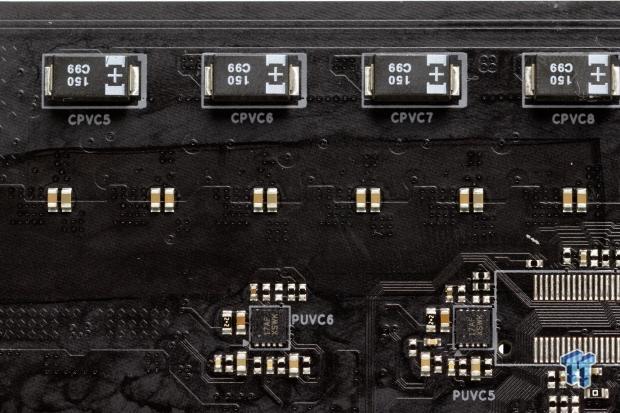

Moving to the rear of the board, we start at the top where we find the phase doublers used on the CPU power phases. We also see a row of aluminum electrolytic capacitors, which are nice, but in many cases, expensive additions when deployed in large quantities.
Next up is the rear of the socket, where we find a large number of ceramic caps, along with two smaller tantalum capacitors with a 150 microfarad rating. These are excellent additions and something we have seen slowly starting to take residence in the rear of the socket area.
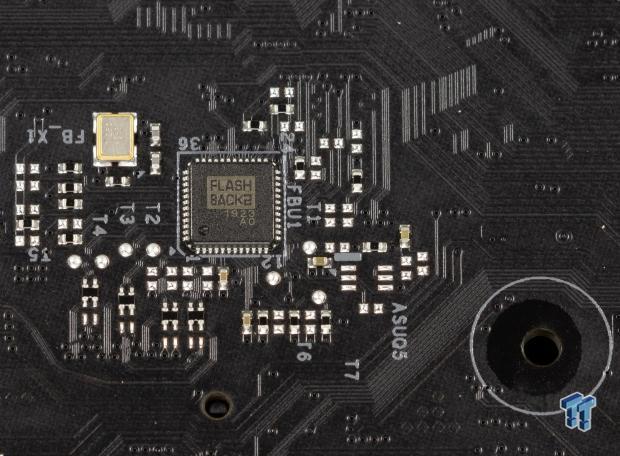
Here we have the chipset labeled FlashBack 2, which is as you can probably guess used for the USB BIOS flashback function. This chipset allows for the boards UEFI to be flashed without a CPU in the system.
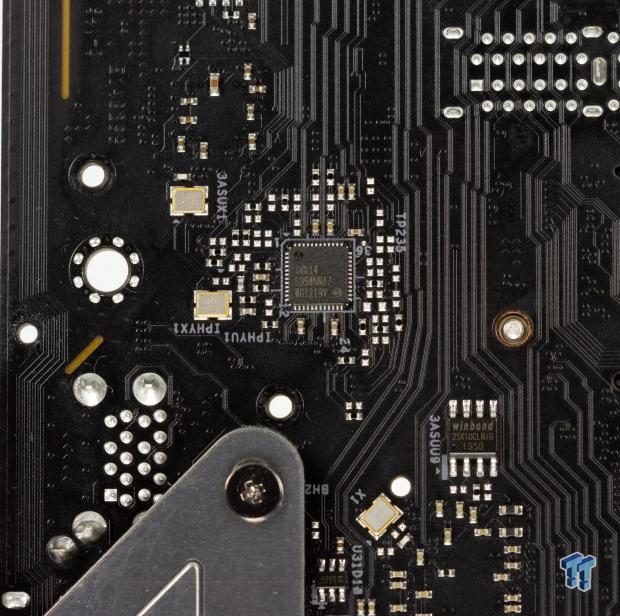
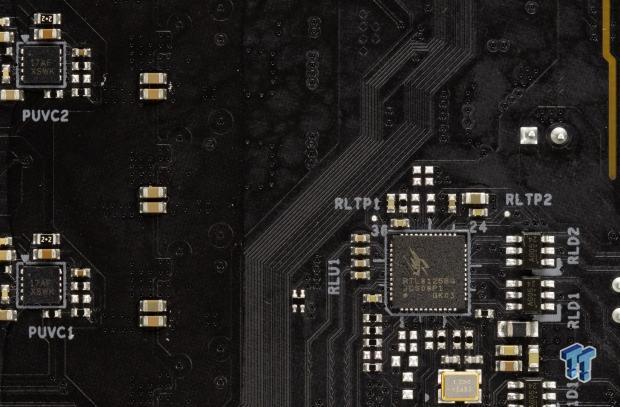
The last two parts on the rear of the board are the LAN chipsets. First up is the gigabit LAN, which is an intel I219V chipset.
The other chipset is labeled as a Rocket RTL8125BG, but for anyone who has been around the tech world for a while, we know that RTL part numbers are Realtek LAN. The only reason I can assume they are using the Dragon branding is to separate the Realtek name from the story, as some users abhorred Realtek in the past. We will test this solution and see if we have any issues with it in packet and file transfer testing.
BIOS/UEFI and Software
ASRock UEFI
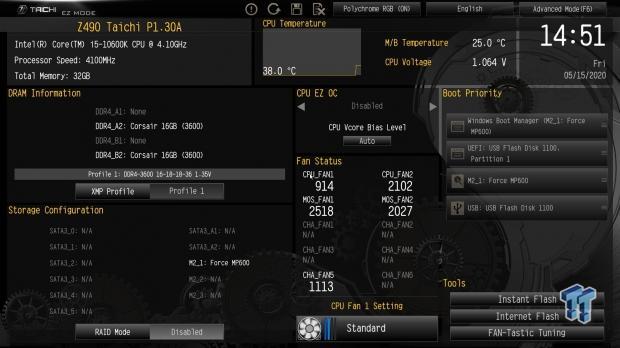
Moving into the UEFI, and you are greeted by the very user-friendly easy mode interface. Of course, we will be moving directly to the advanced mode. We will show you several screenshots of the UEFI below.
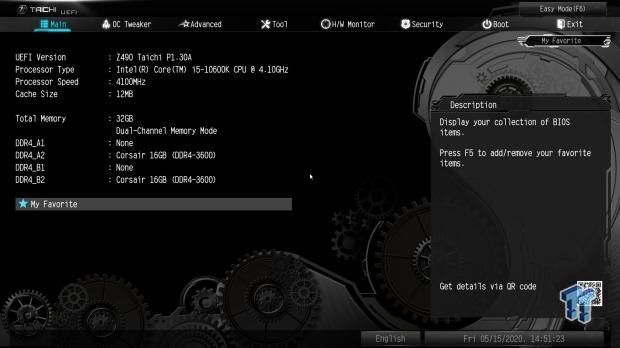
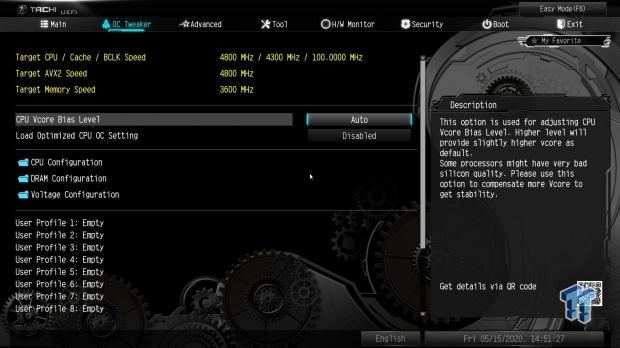
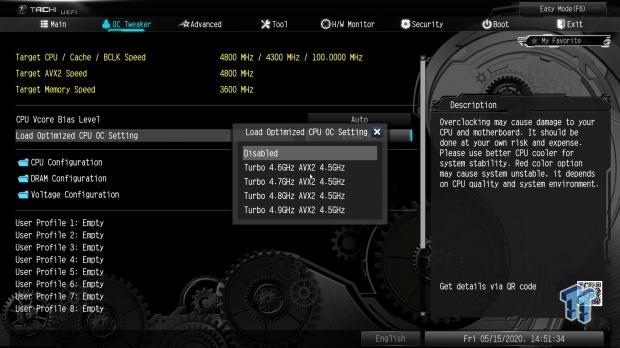
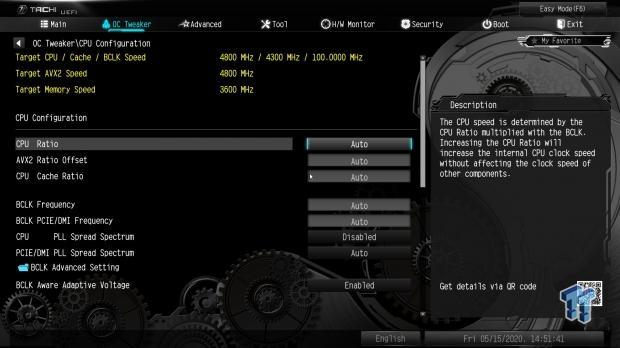
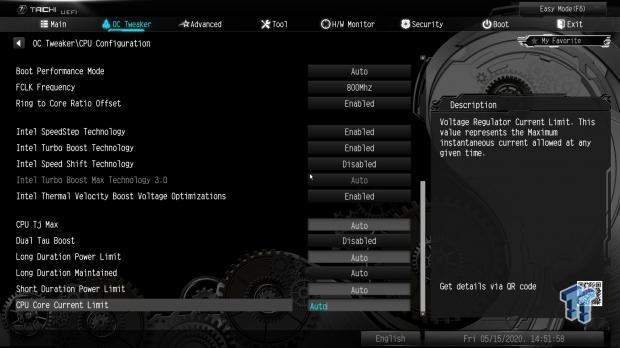
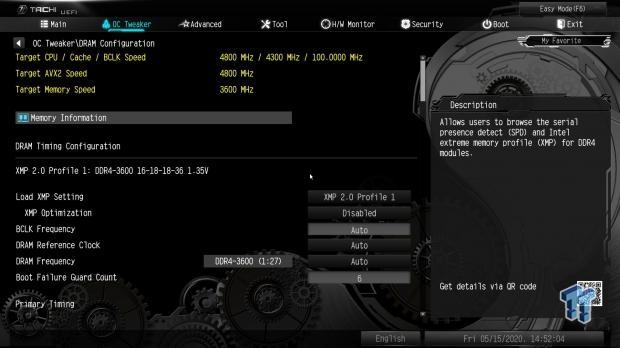
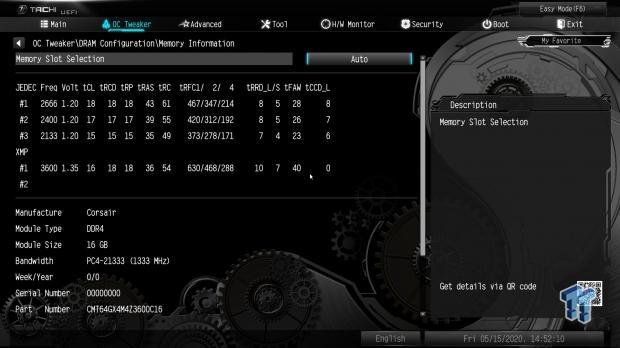
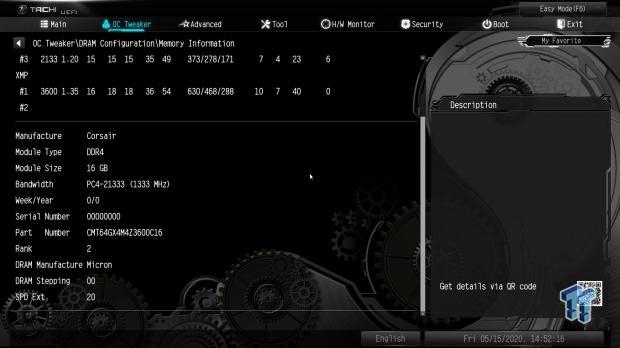
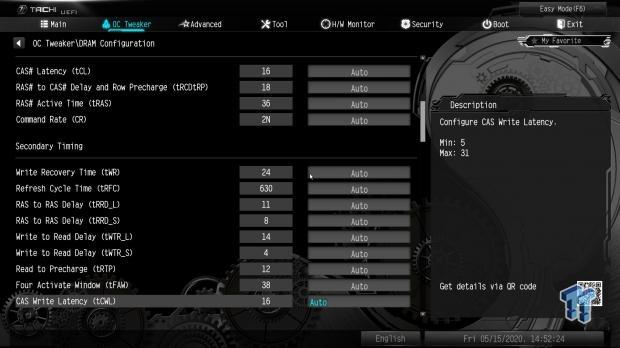
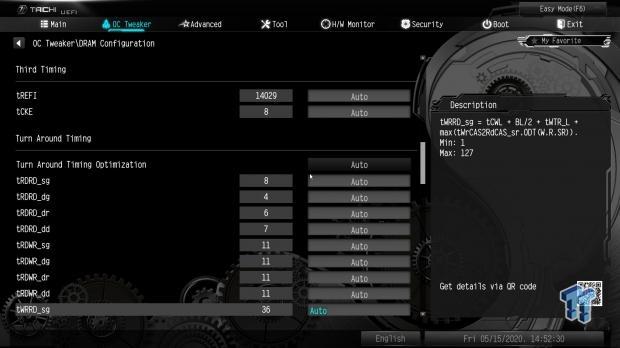
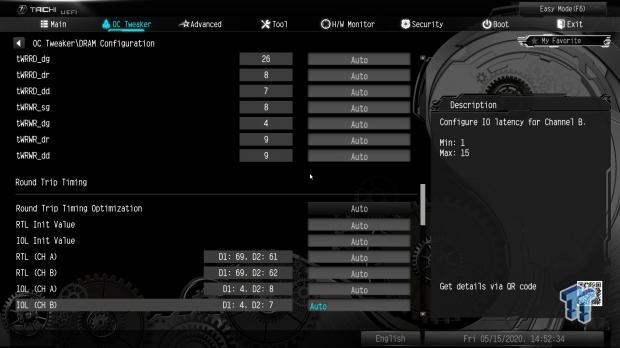
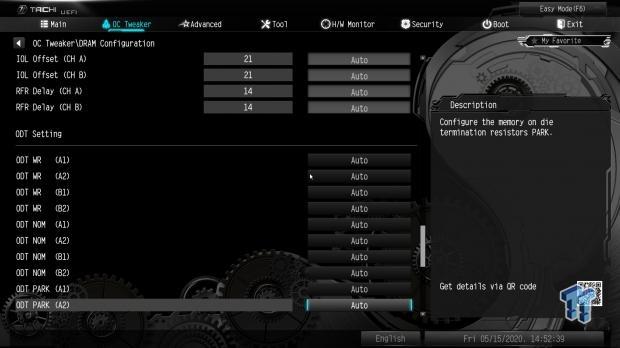
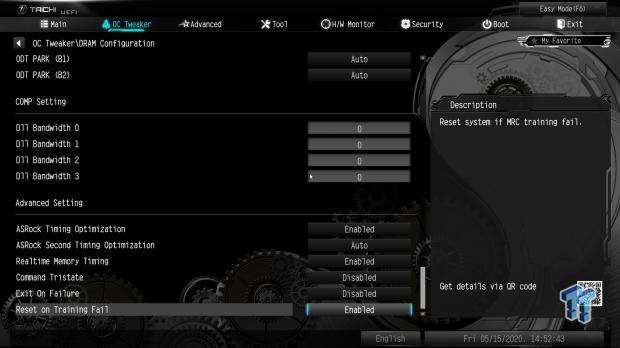
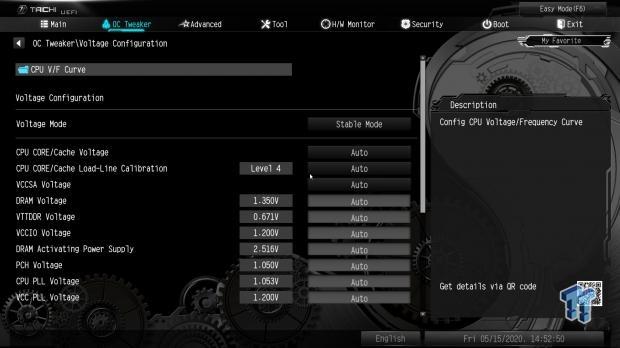
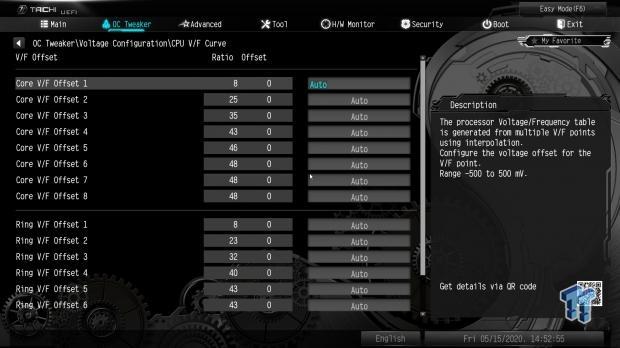
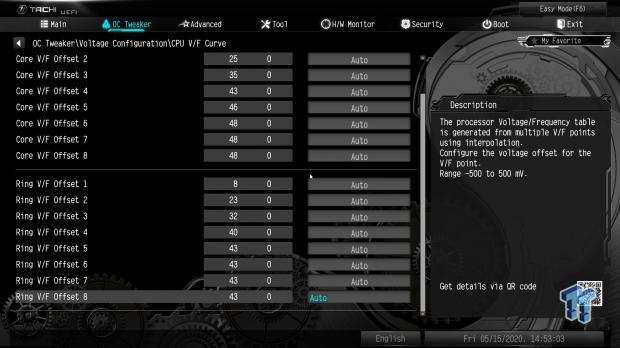
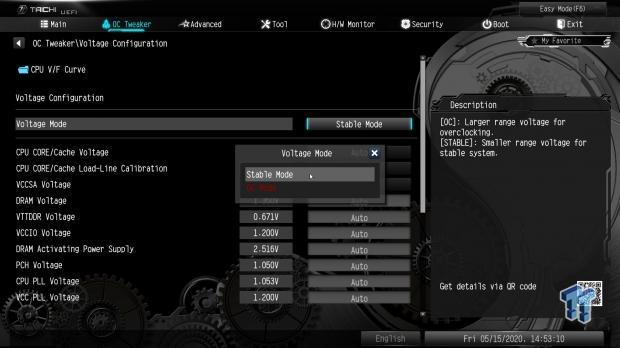
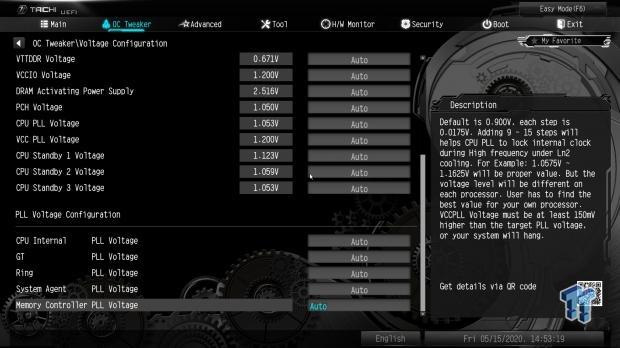
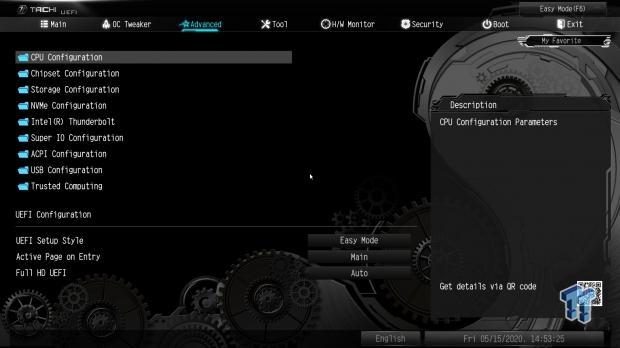

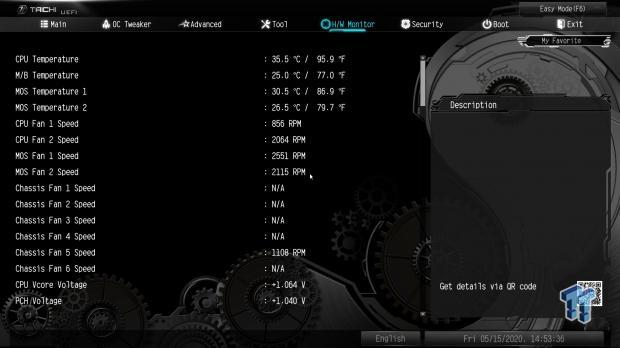
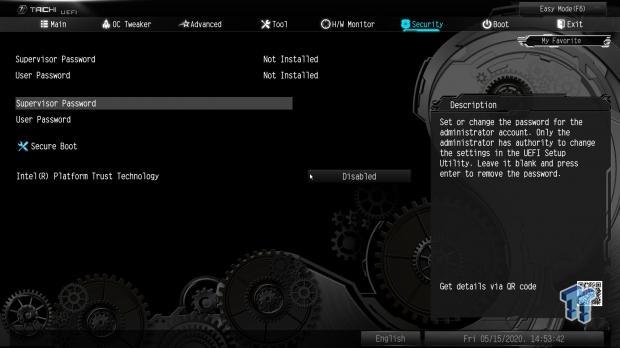
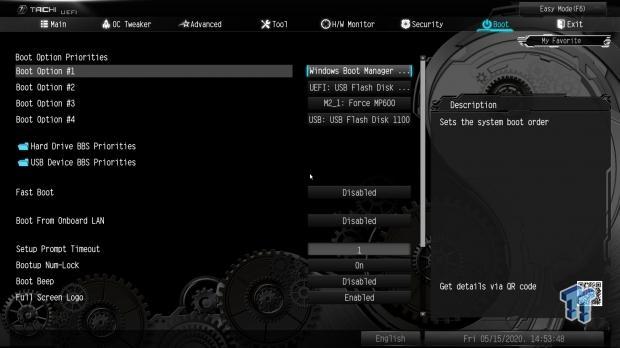
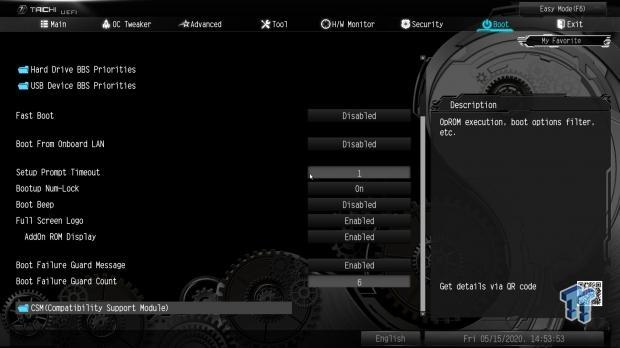
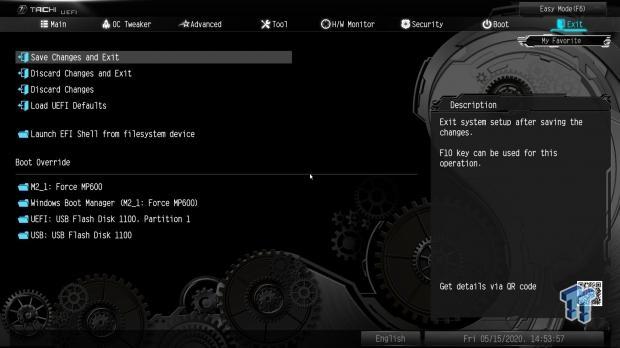
It seemed appropriate to end with the save/exit screen as we move into the OS and look at the software.
ASRock Software
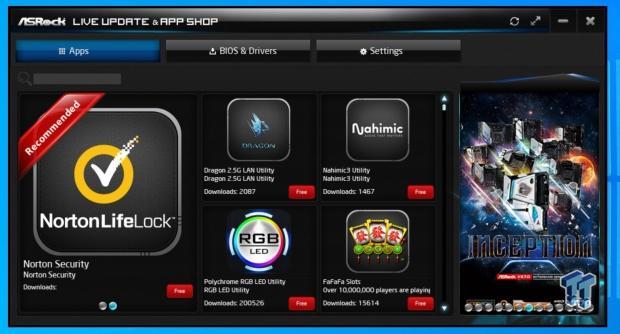
Upon installing the software, we are greeted by the app shop interface, which has the LAN utilities along with RGB and other ASRock based utilities. One thing I hope most people avoid is the strange slots game, which is in the listing but seems odd to include in motherboard software. Also, I'm not a huge Norton fan as they have proven to be utter crap over the years, and well, that red "recommended" ribbon is not merited in my mind. But marketing is marketing.
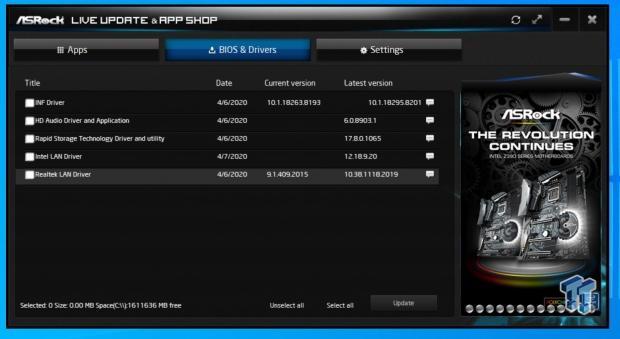
Moving to the driver tab, we see the selection of drivers available. Here we also see the Realtek LAN driver, which further confirms what we already knew, which is that Dragon 2.5G LAN is indeed Realtek.
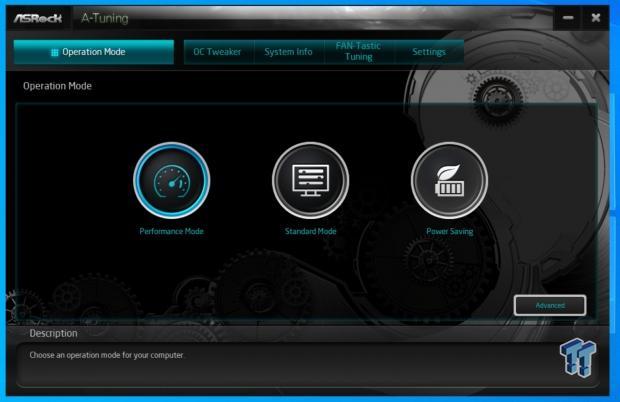
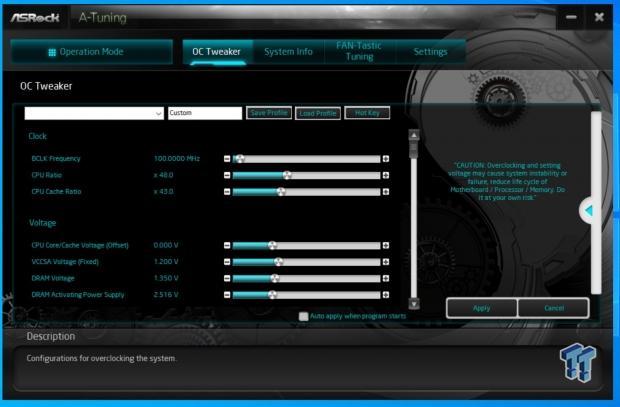
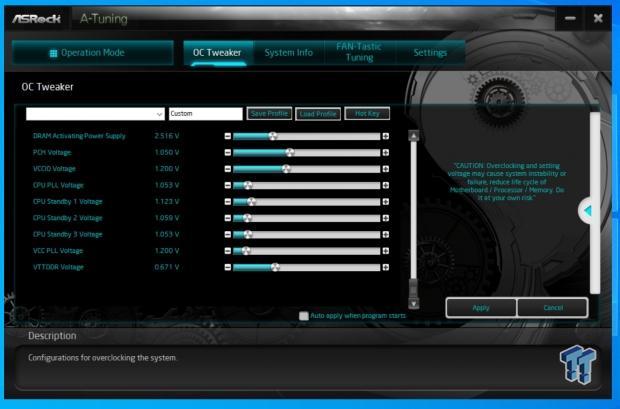
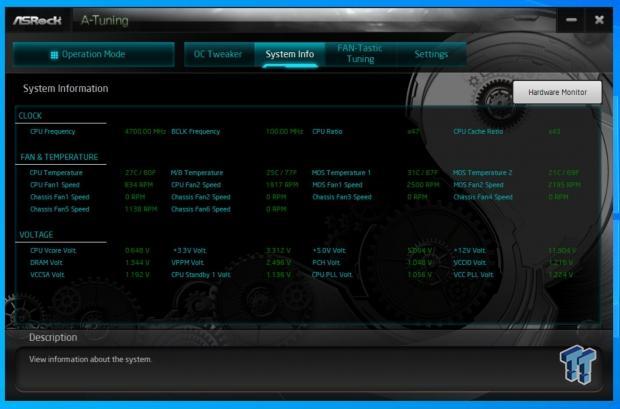
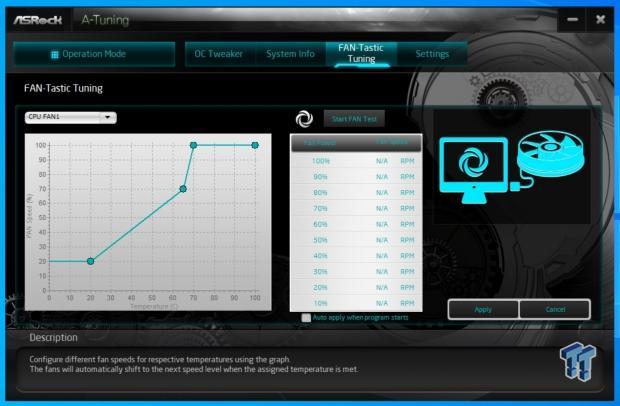
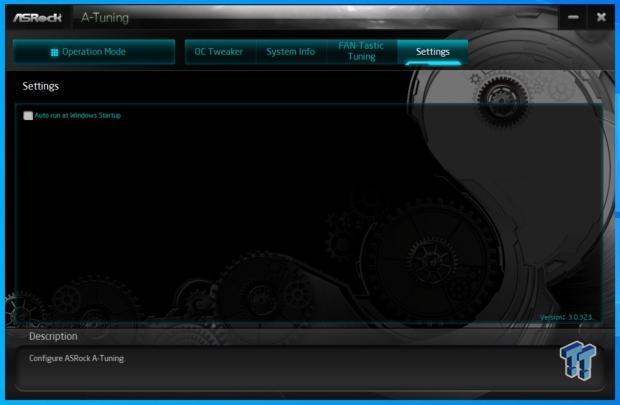
Here we have the A-Tuning utility, which is the all-in-one suite for monitoring, reporting, and tweaking motherboard settings. Here you can do everything from OS level overclocking to profile quick turning and also monitoring clocks and vitals of your system.
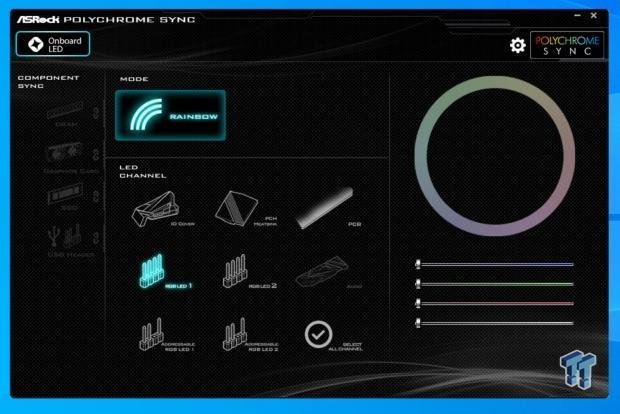
Here we have the Polychrome RGB application, which is used to control the onboard RGB along with the external headers for LED strips or other devices to sync.
Test System and Configuration
Test setup
My testbench is strictly controlled with a fresh OS for any platform or component change. The system uses all the same components whenever possible to maintain comparable results between platforms. The ambient in the test lab is rigorously controlled at 22C +/- 1C. All tests are run a minimum of three times, and any outliers are discarded, and a replacement test run will be completed to achieve our average results. The use of a TITAN RTX for the testing is to ensure that the GPU is not the bottleneck for performance results, and will best represent the scaling across CPU and platforms.
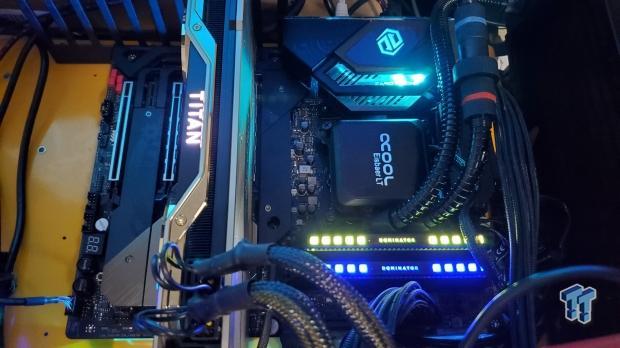
- Motherboard: ASRock Z490 Taichi (buy from Amazon)
- CPU: Intel Core i9 10900K
- Thermal Paste: Arctic Cooling MX-4 (buy from Amazon)
- Cooler: Alphacool Eisbaer LT 360mm (buy from Amazon)
- Memory: Corsair Dominator RGB 3600MHz 16GBx2 (buy from Amazon)
- Video Card: NVIDIA TITAN RTX (buy from Amazon)
- Storage - Boot Drive: Corsair MP600 (PCIe 4) 2TB (buy from Amazon)
- Network Switch: Buffalo Multi-Gigabit BS-MP2008 (buy from Amazon)
- Testbench: DimasTech Easy XL (buy from Amazon)
- Power Supply: Thermaltake 1200W (buy from Amazon)
- OS: Microsoft Windows 10 (buy from Amazon)
- Monitor: ASUS XG438 43" 4K (buy from Amazon)
- Video Capture: Elgato 4K 60 Pro (buy from Amazon)
- Keyboard: Logitech G910 Orion Spectrum (buy from Amazon)
- Mouse: Corsair Logitech G502 (buy from Amazon)
WPrime, SuperPi, Cinebench, and AIDA64
WPrime
WPrime is first up and being a multi-threaded benchmark. We know it will scale with any CPU we throw at it. You can manually set the number of workers or threads you want to allocate to the calculation, which we did the total thread count for each CPU to ensure we measure the maximum performance the CPU can offer.
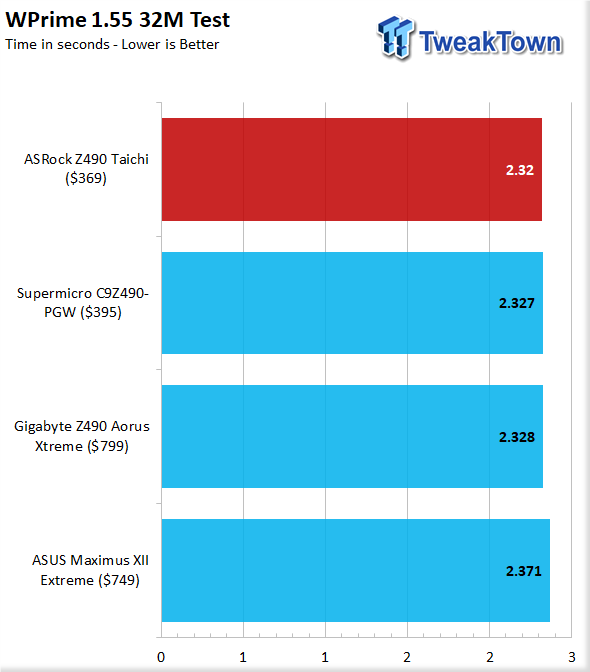
The 32M test is the shorter one and shows how each CPU performs with a quick burst multi-core loading. Here as expected, we see that all of the boards we have tested thus far line up quite closely.
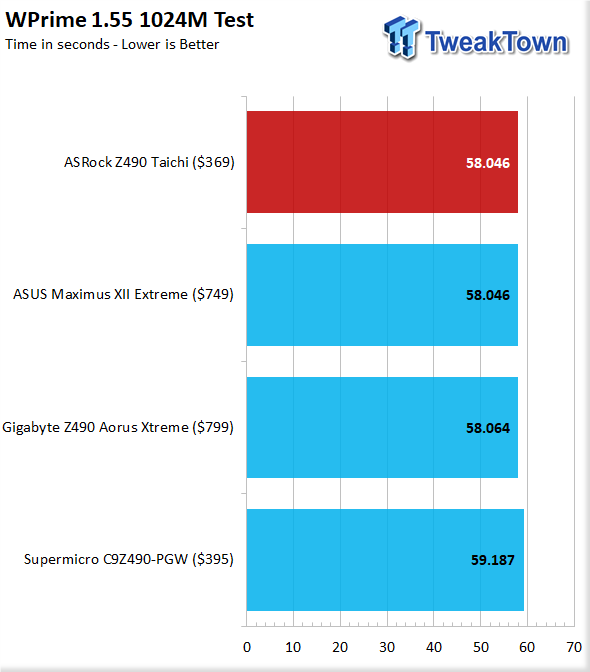
The 1024 test is the more extended version and can take form as short as under half a minute up to several minutes depending on thread count and frequency of the CPU being tested. Here we see that the more extended test kept the same result staging with all of the boards so tightly grouped it's a literal wash.
SuperPi
SuperPi is a much older test, but it's worth including as it is a single-threaded computation workload that really can show in granular detail differences in the computational ability of the silicon being tested. One thing to note is that this is an aging application that tends to favor intel architecture, so don't be surprised when you see much better results by some chips, as those same chips you will see get beaten in other tests.
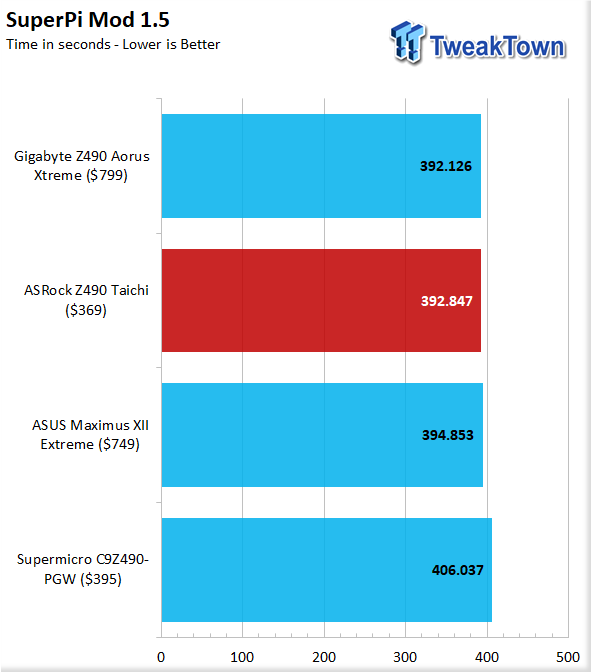
With SuperPi, it is a single-threaded workload, which can show the base efficiency of a platform. Here we see the motherboards start to see some separation with the Z490 Taichi pulling a respectable
result, just on the heels of the top contender of the boards we have tested.
Cinebench
Cinebench is a long-standing render benchmark that has been heavily relied upon by both Intel and AMD to showcase their newest platforms during unveils. The benchmark has two tests, a single-core workload that will utilize one thread or 1T. There is also a multi-threaded test which uses all threads or nT of a tested CPU
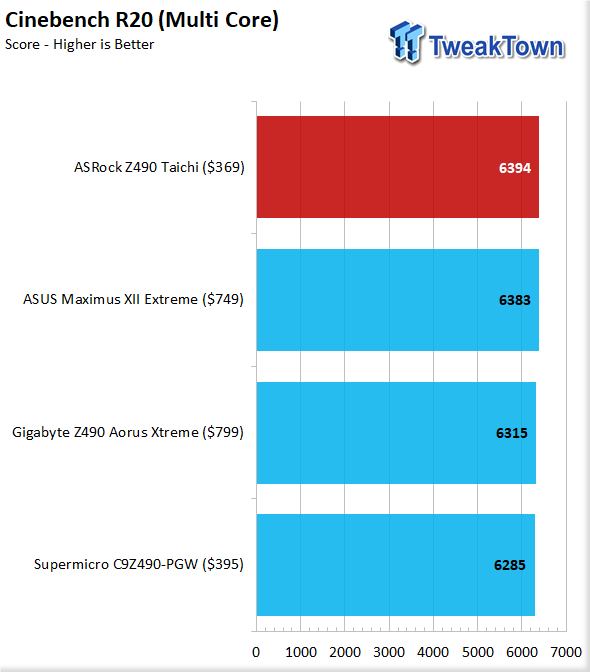
The multi-core test for Cinebench shows a close but defined spread to the pack, but the Taichi leads the group on this run.

Moving to the single-threaded test and we see the Taichi take the top spot once again. When considering the price point of the Taichi, I cannot help but notice a serious value starting to form here.
Aida64
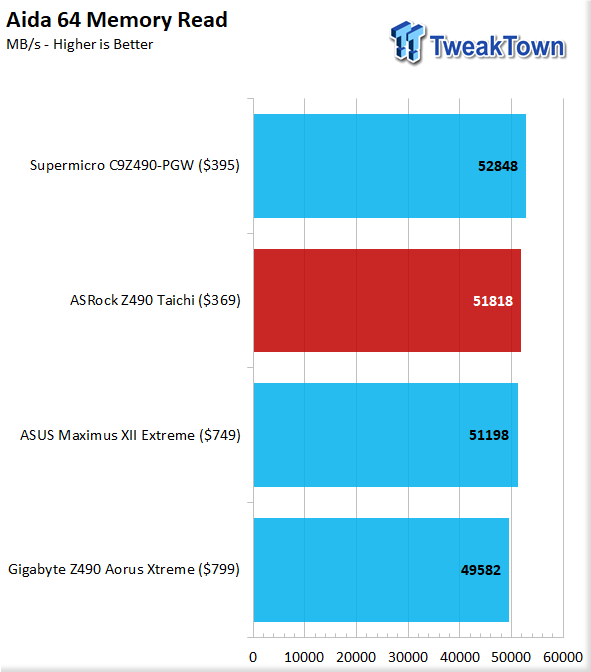
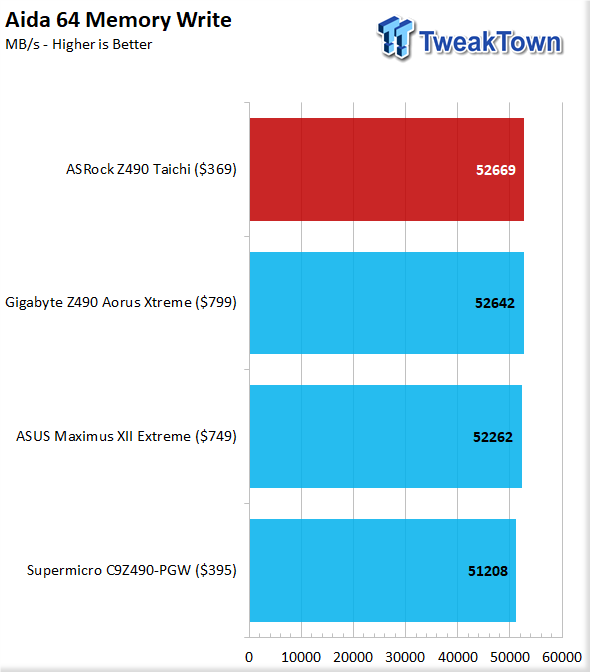
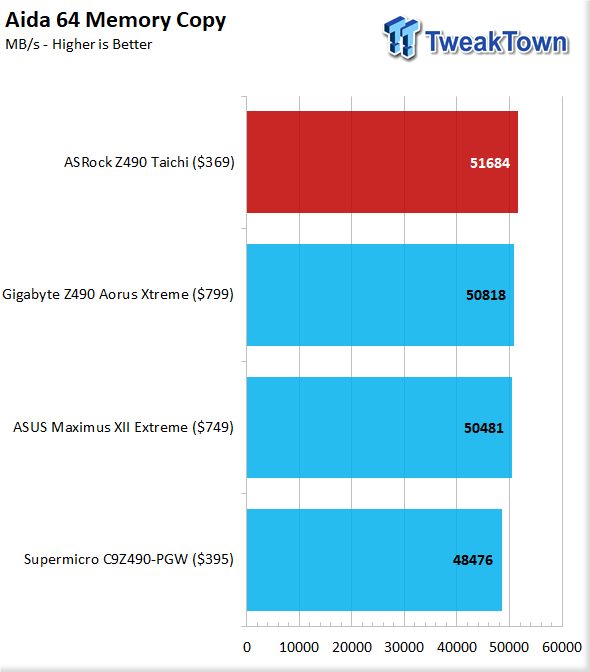
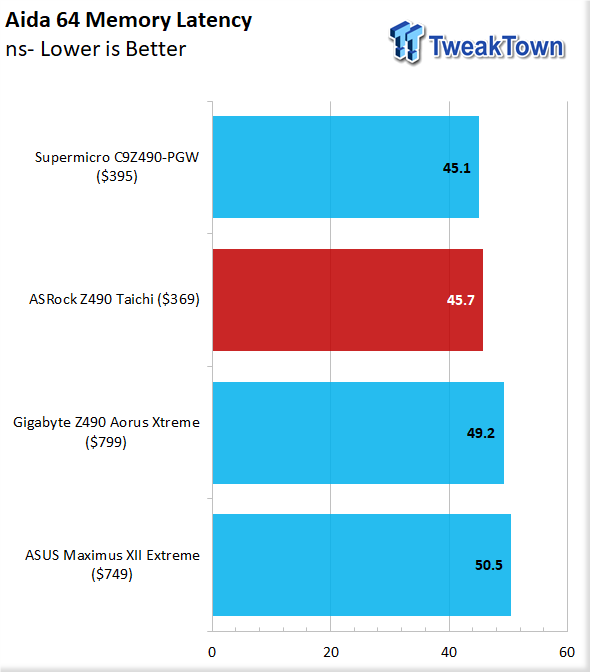
Moving to Aida64, we start with memory performance. The Taichi loses to the Supermicro board on the read section but makes up for it in the write and copy tests. However, the Supermicro edges out the Taichi ever so slightly on the latency result.
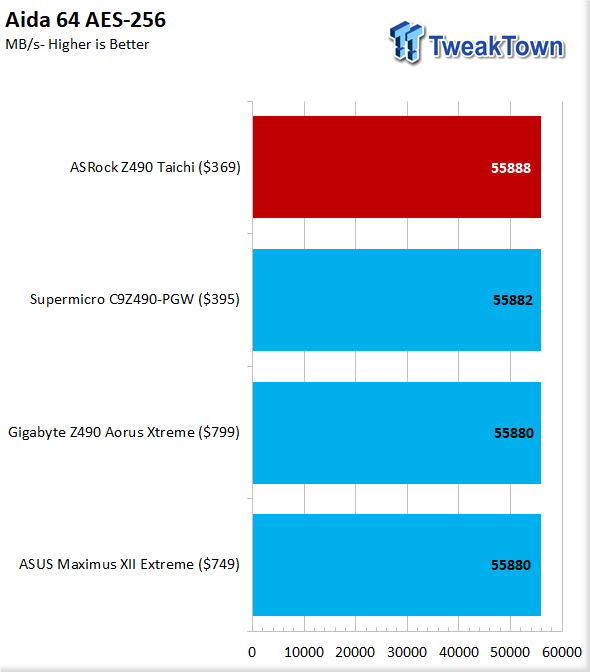
The AES encryption test gives a result in MB/s, and while the Taichi leads, the grouping is so tight that only 8MB/s separates the Taichi from the bottom Z490, so far. The difference is less than a thousandth of a percent, aka they are the same in this test.
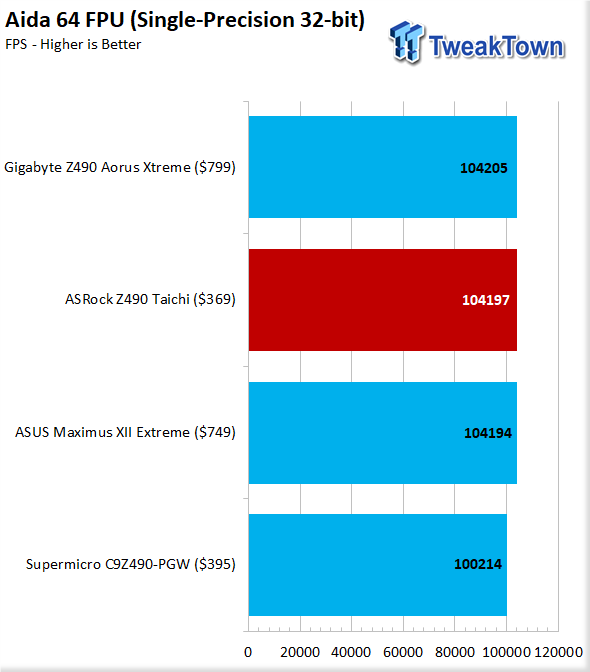
For FPU testing, we have 32-bit single-precision first. Here we see the top three boards all sharing the same space with the Aorus Xtreme edging out a win. The Taichi comes in very closely behind with the Maximus XII Extreme from ASUS right on its heels. Being in the same range as boards over twice the cost is an excellent place to be.
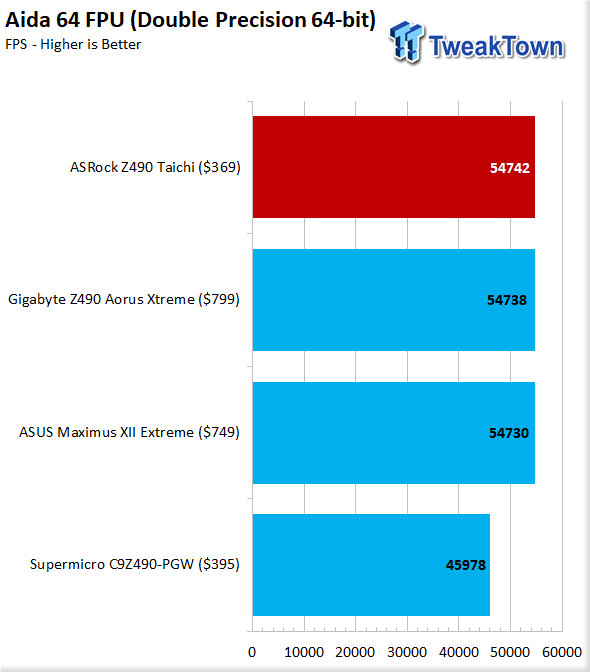
Now with the next level, we have the 64-bit double-precision test. Here the Taichi took a top spot once again, barely edging out the Z490 Aorus Xtreme. The Maximus Extreme slots in, right behind that, and the Supermicro falls a bit behind as it seems to more strictly follow the Intel guidelines for turbo boost durations and power.
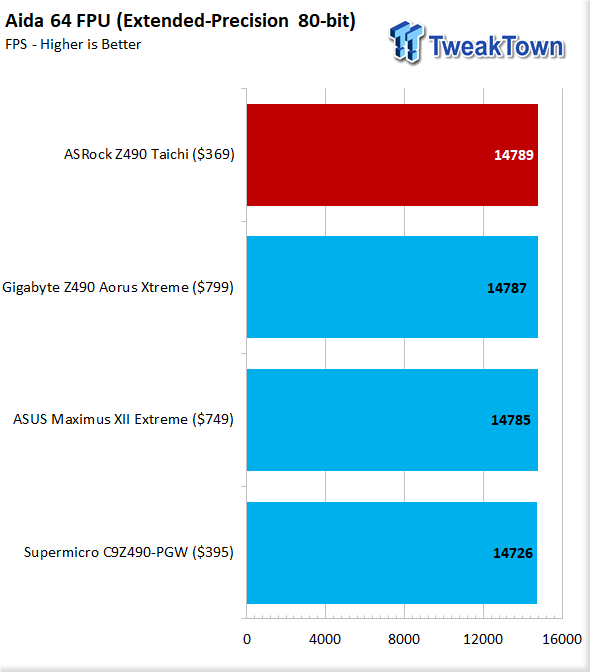
Lastly, we have 80-bit extended precision; This test equalizes things once again with a few FPS separating the pack. The only exception is the Supermicro, which falls off the pace but not nearly as dramatic as the double-precision test.
Handbrake, Blender, POV-Ray, CoronaRender, 7-Zip, and WebXPRT
Handbrake
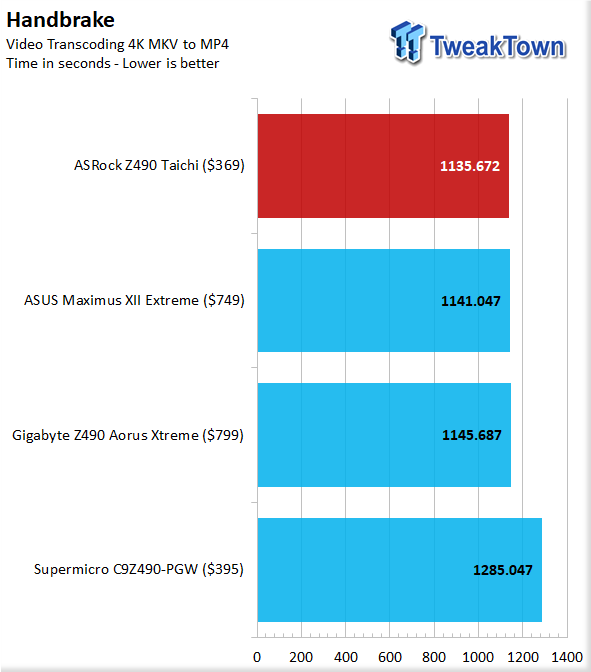
Handbrake is up next, and we are transcoding a 4K MKV to MP4. Here we see once again the Taichi take a leading position, but the other two top contenders are within 5 seconds of each other in the line of succession.
Blender
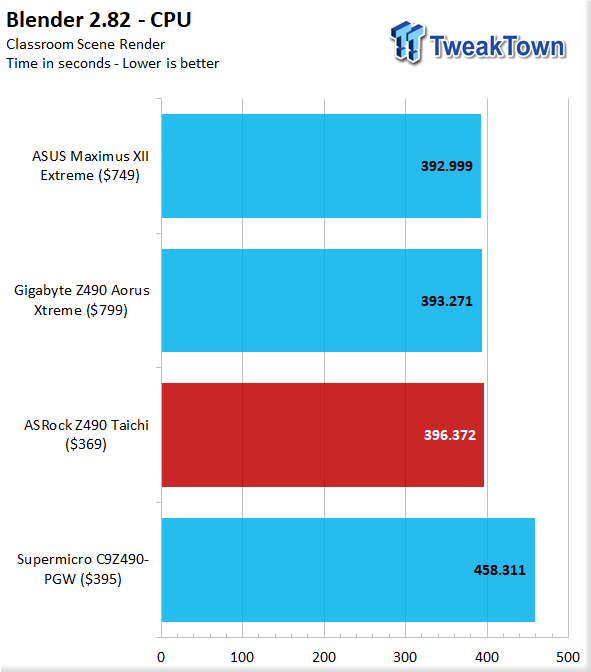
Moving to Blender, and the Maximus Extreme and the Aorus Xtreme both step ahead of the Taichi ever so slightly here. Overall a displacement of three seconds on a six and a half minute render can add up; it simply won't be enough to justify omitting the Taichi.
7-Zip
7-Zip is an open-source and free compression application. It works well with multi-threading and also can see gains from clock speed as well.
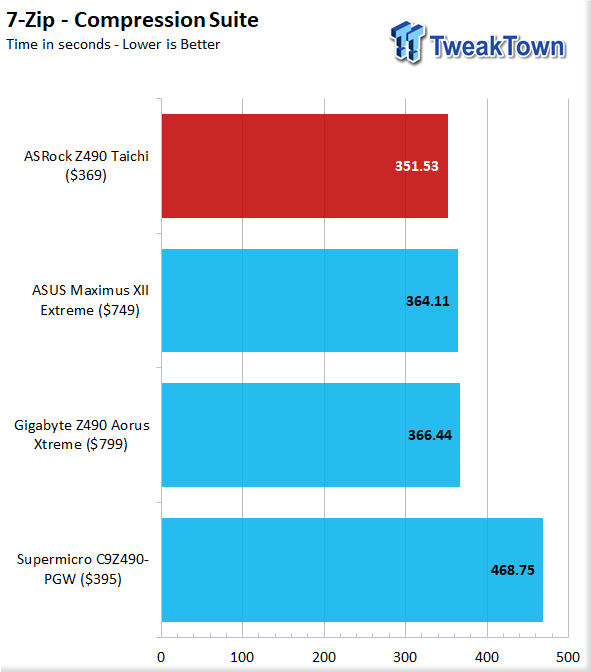
Moving to the 7-Zip compression suite, we find that the timed benchmark sees excellent efficiency form the Taichi with it leading the pack by almost 13 seconds. The two top contenders, the Aorus Xtreme and the Maximus Extreme are within two seconds of each other, but they have fallen far enough from the Taichi to consider it a solid win.
WebXPRT
WebXPRT is a browser-based test, and we like this test as this is one of the areas not many think to test. This also happens to be a real-world usage test that can be impacted by the mitigations which have recently rolled through and were patched.
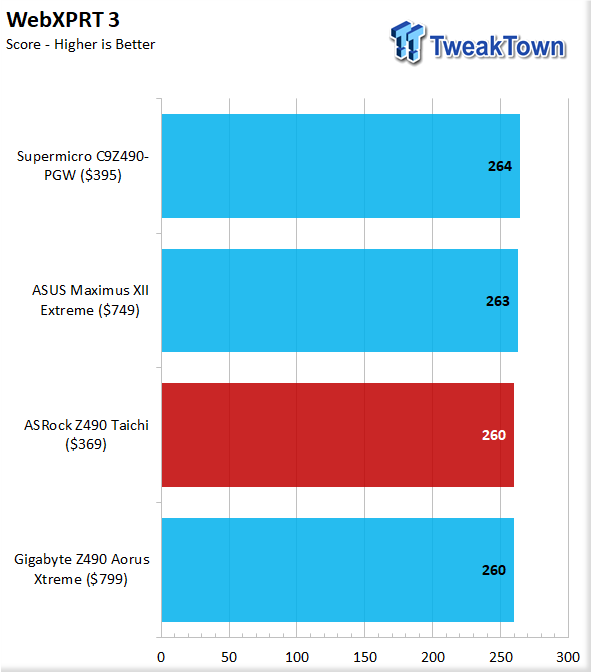
WebXPRT sees the Taichi match the Aorus Xtreme here, with the Sueprmicro jumping to the lead in this test. The Maximus Extreme is right on the heels of the leader in this instance.
Unigine and UL Benchmarks
Unigine Superposition
Superposition from Unigine is a DX12 based benchmark. We test with the 720P LOW preset as this removes all but the most basic GPU loading, and all of the FPS performance comes from the CPUs ability to push frames to the GPU. This test is far more efficient and speed based rather than being highly threaded.
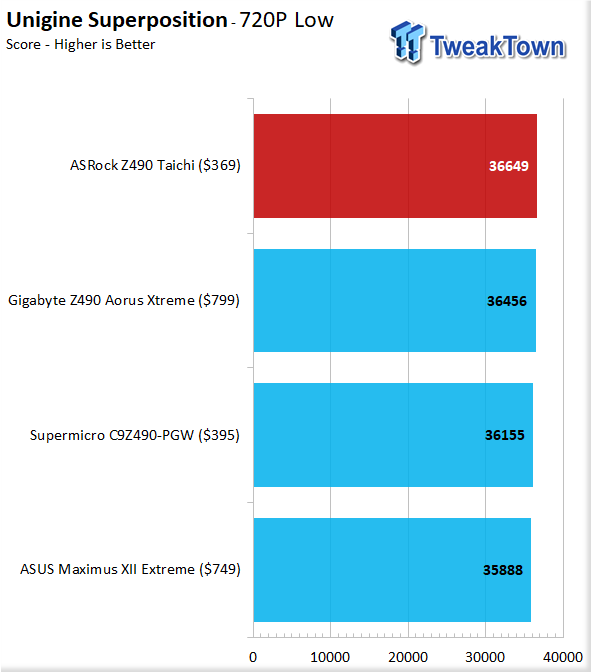
Unigine Superposition is one of our 3D gaming loads, and we test it at the 720P low preset to remove the GPU from the equation as much as possible and show the impact of the system on graphical performance. Here we see the Taichi take a notable lead of around 200 points, which is good considering the price category the competing boards fall within.
PCMark 10
PCMark is a benchmark from UL and tests various workload types to represent typical workloads for a PC. Everything from video conferencing, image import, and editing, along with 3D rendering, are tested.
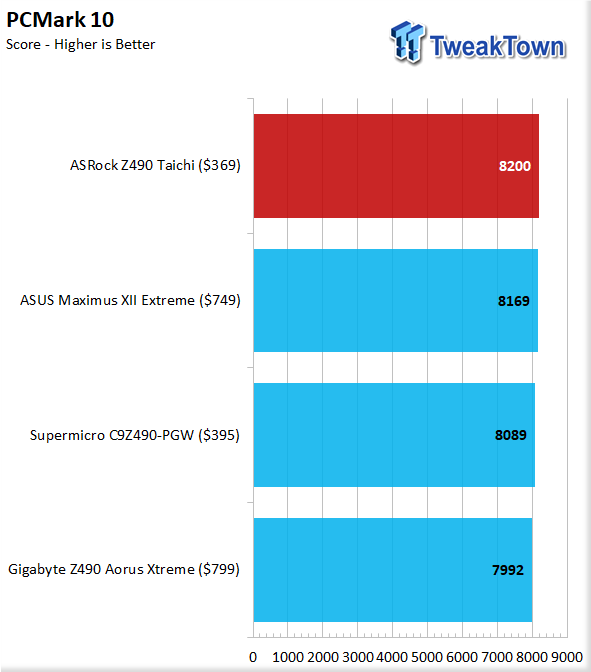

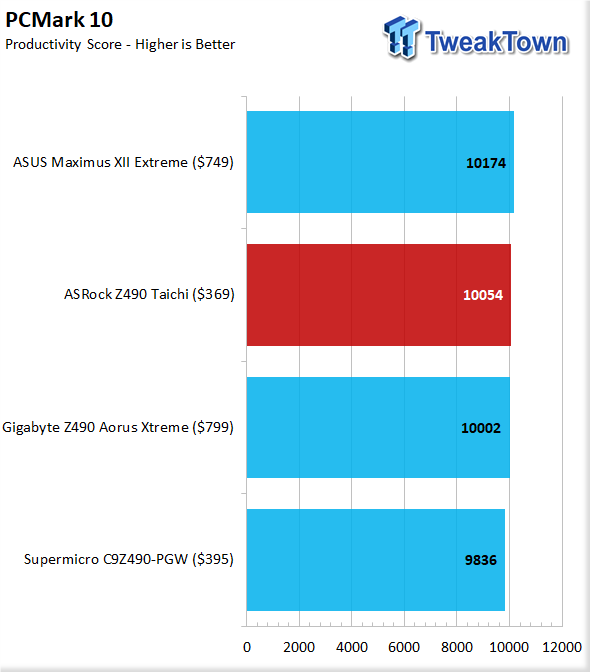
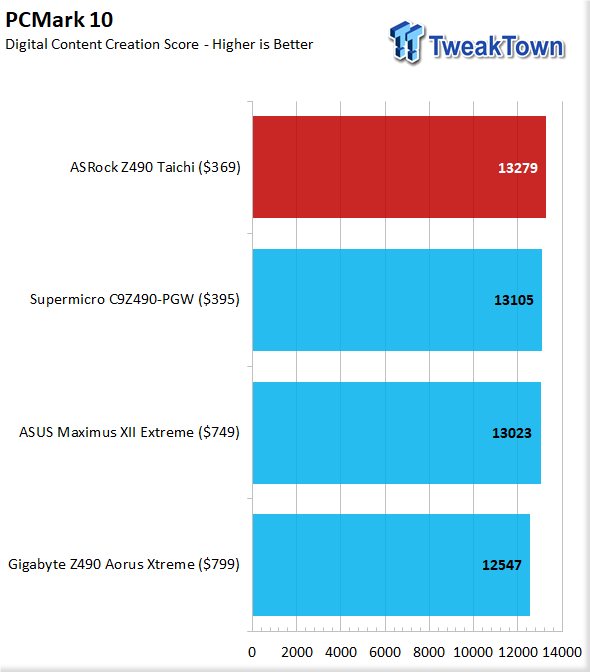
The overall result, the Taichi takes the cake for PCMark 10. However, when looking at the subtests, we see that Taichi wins three of the four. The productivity score the Maximus Extreme takes a decent lead.
3DMark Firestrike
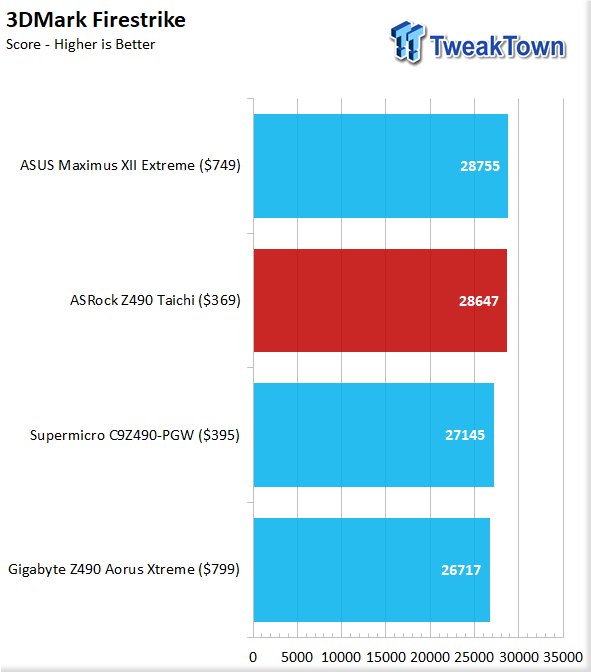
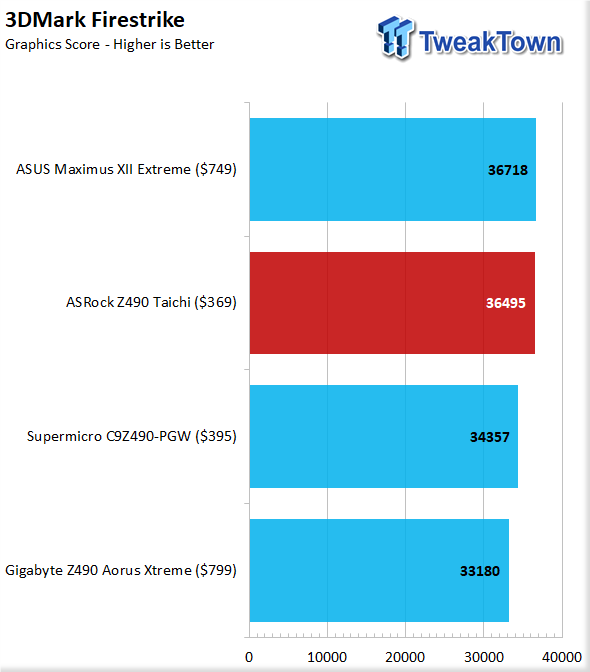
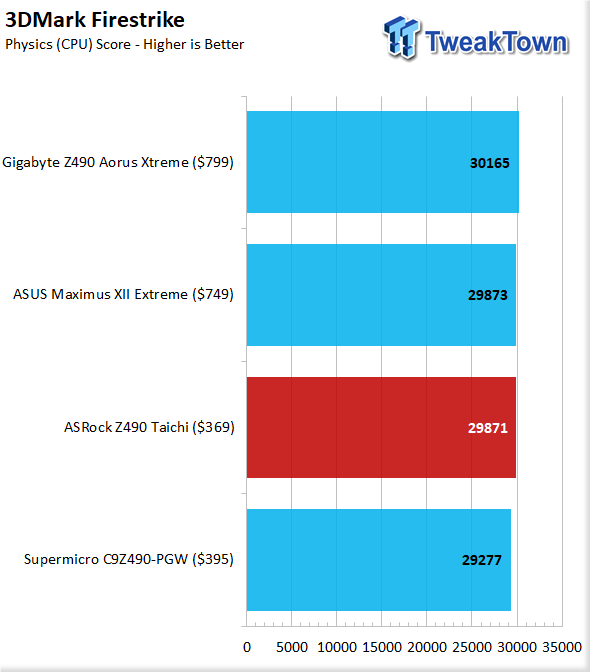
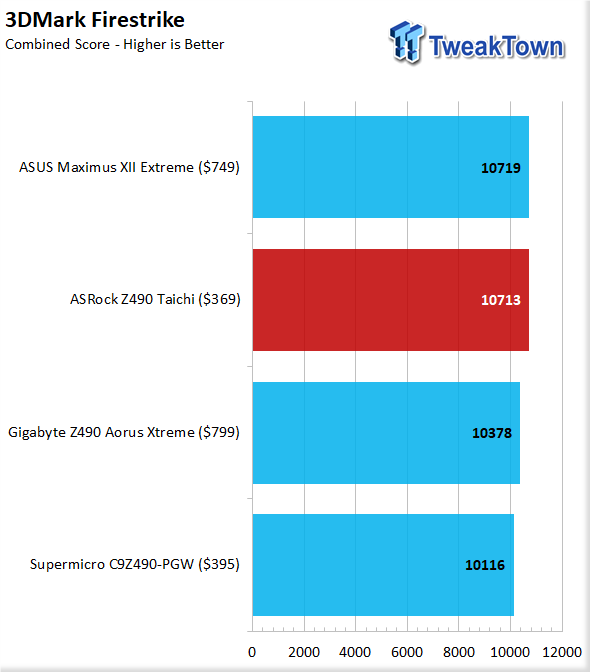
3DMark Firestrike is our second graphics or synthetic gaming test. Here we see the main score the Taichi falls to the Maximus Extreme. The graphics score shows more of the same, while the Physics score shows the Taichi fall below both top contenders. The combined score shows the Taichi right on the heels of the Maximus. It seems for this kind of workload; the Maximus has a little more in the tank for pushing frames.
3DMark Time Spy
Time Spy is another 3DMark test variant, but this one is for DX12 based systems. This test can be quite stressful, and since its an entirely different load, you may be surprised to see how the results shuffle when compared to Firestrike.
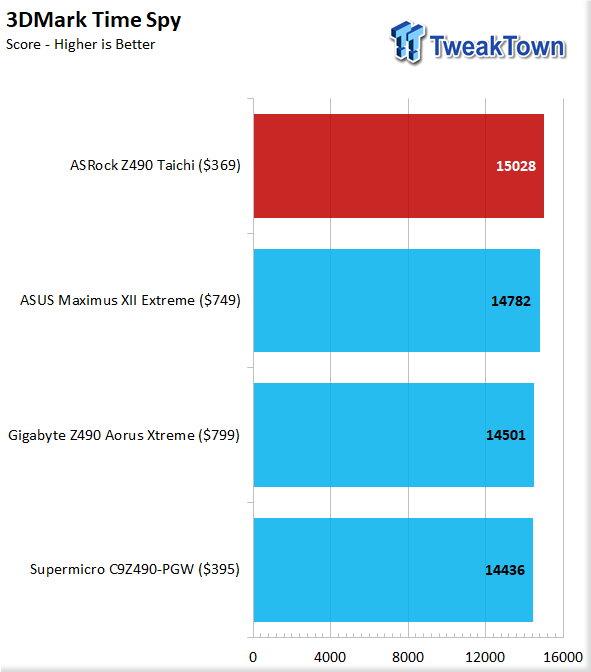
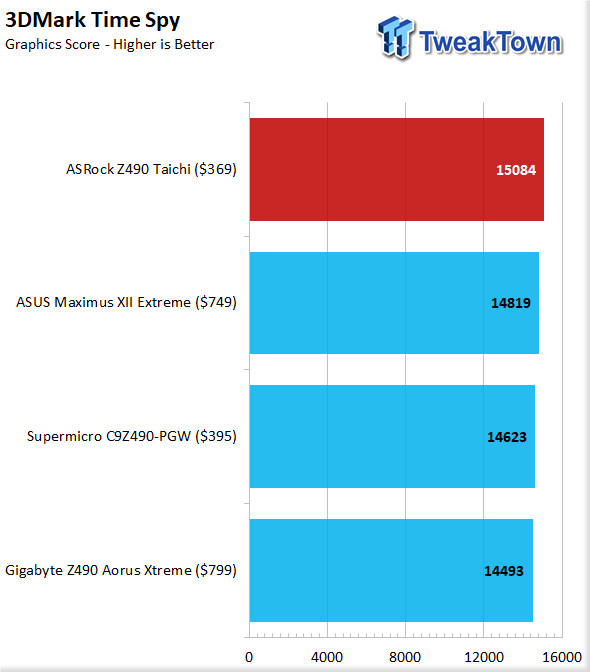
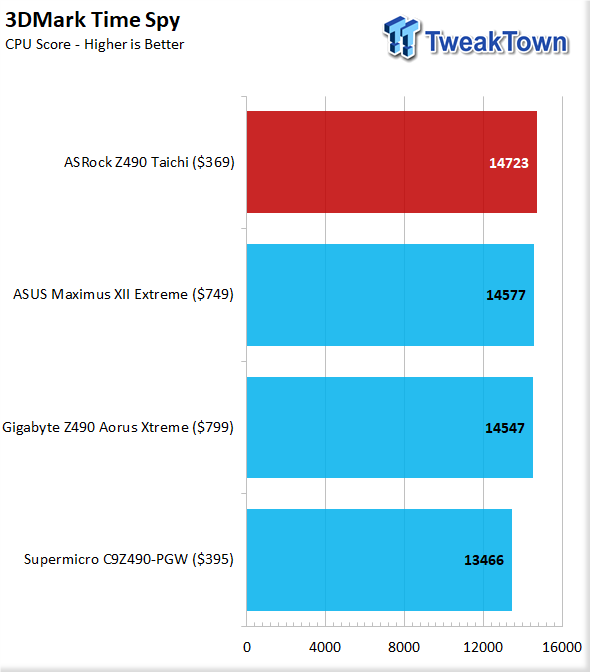
Moving to the newest graphical and gaming benchmark in the UL suite, and we see the Taichi take the top spot in every portion of the test.
This shows some serious performance potential not just in CPU work but gaming as well, and if the positioning is any indication thus far, it does the job with quite the value as well. Next up, we assess the system's I/O performance.
System I/O Benchmarks
Storage: CrystalDiskMark
For storage performance, we test the platform using a PCIe 4.0 Corsair MP600 2TB M.2 NVMe drive. It is tested in CrystaldiskMark 7.0.0 x64, and we average the results to ensure a good cross-section of expected performance. Do note that some platforms do not support the new PCIe gen 4, and therefore will cap out around 3400-3500MB/s.
M.2: MP600 2TB
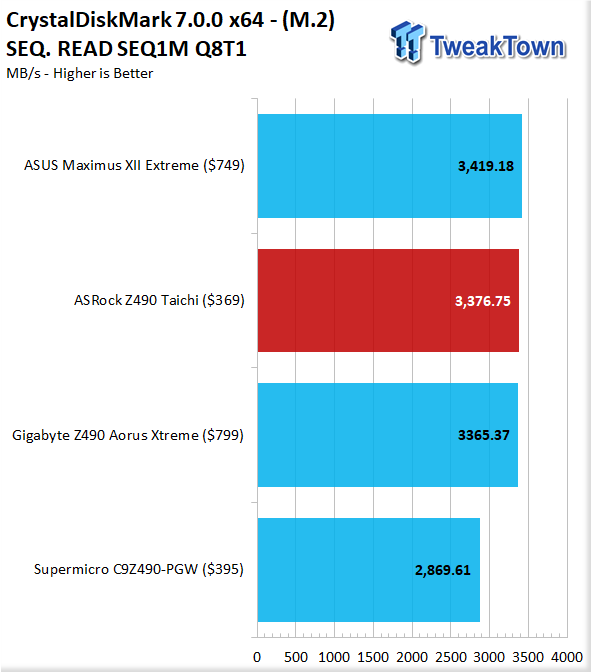
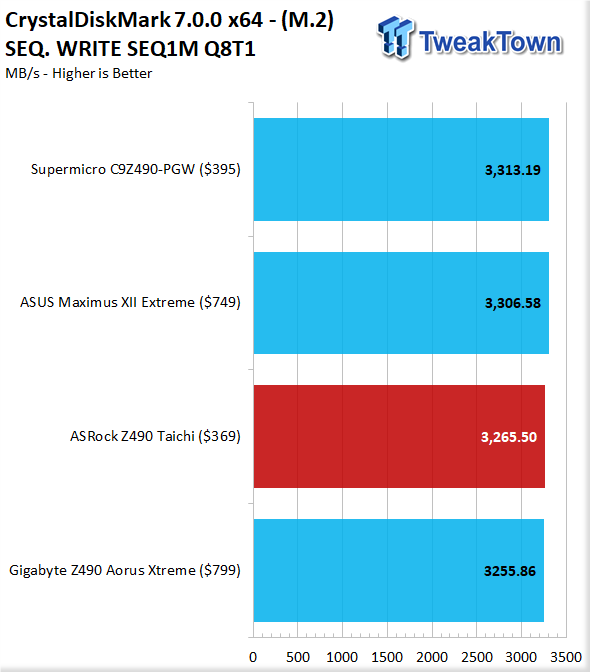

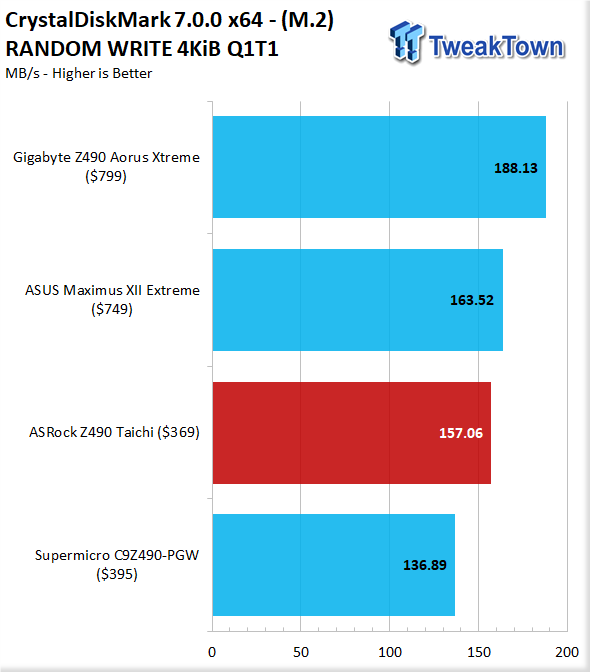
Here, with the MP600, we see the Taichi pull off some respectable sequential read numbers, only being bested by the Maximus Extreme board. Writes shows all of the boards crunch together again. Random reads see the Taichi at the bottom of the pack, while random writes see the Taichi claw its way past the Supermicro.
SATA: T-Force 2350GB SSD
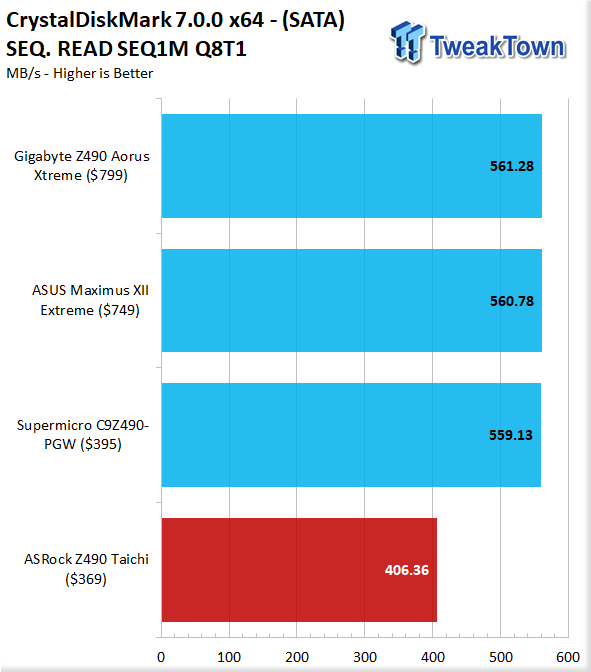
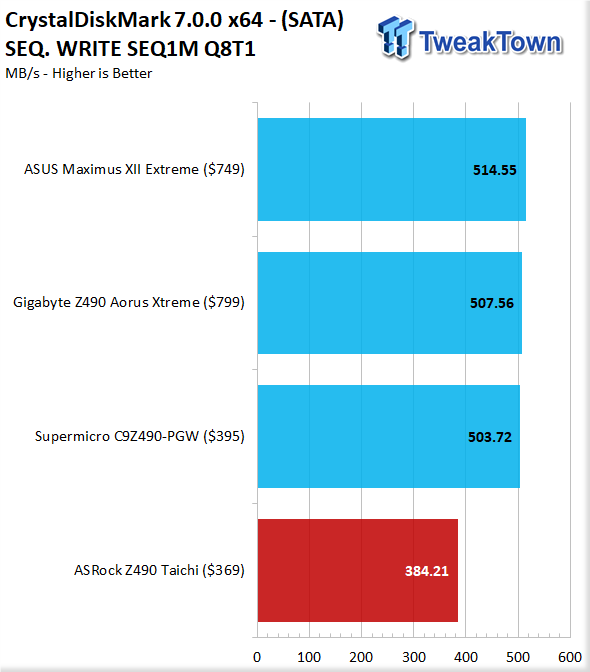
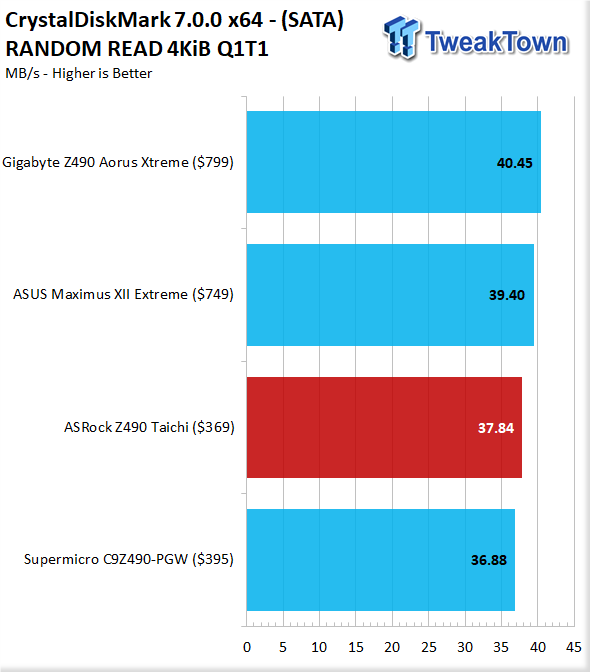
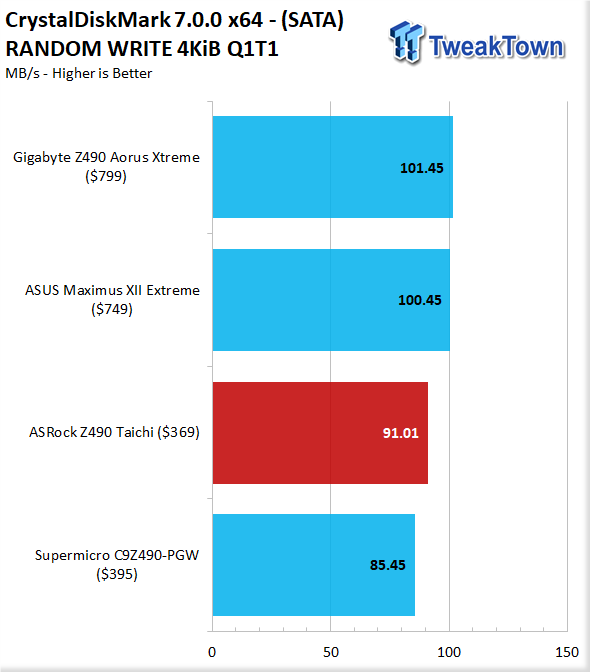
SATA performance was a bit strange as the Taichi showed noticeably lower performance than the other boards. I thought I might have used the wrong port, so I swapped to three different ports and recorded similar results. This is a strange one and speaks to potentially something else hogging some of the PCH lanes or DMI causing this activity.
USB: WD P50 1TB
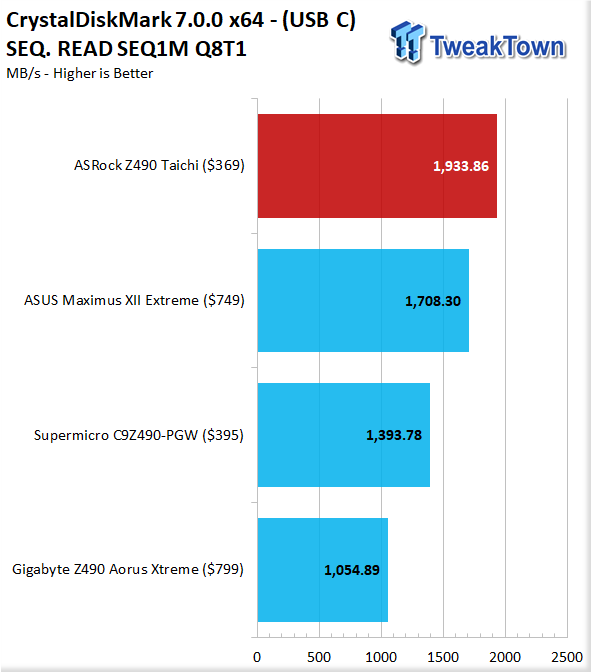
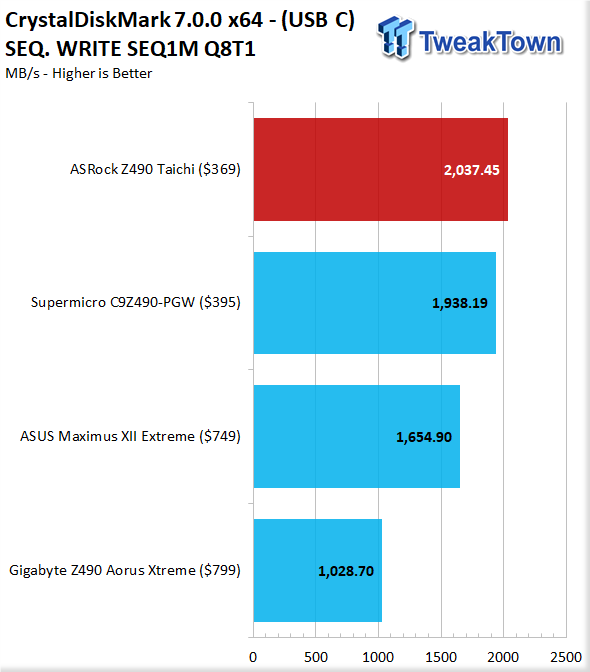
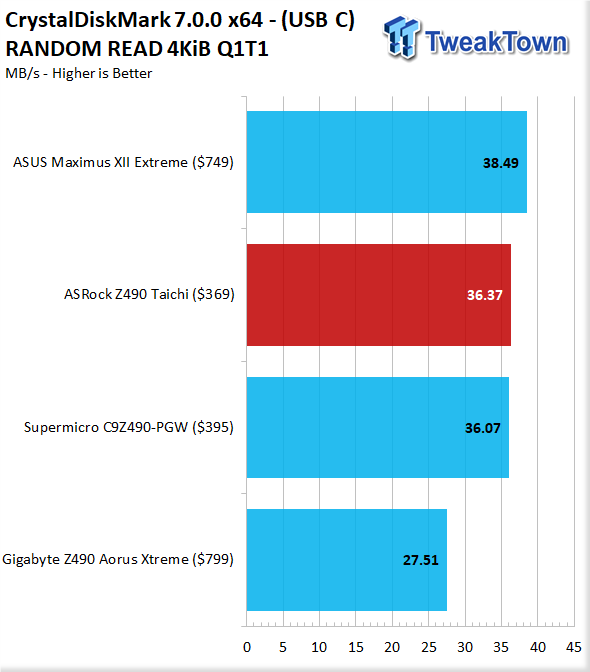
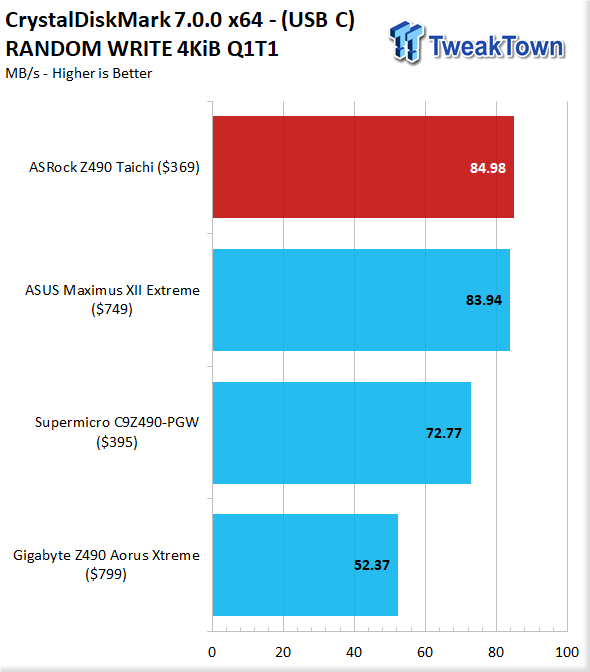
For the external storage, we select the fastest port to test the P50, which is the USB 3.2 2x2 port, and we see a blistering performance result, just short of 2GB/s sequential read. Sequential write it jumps to over 2GB/s, and the Sueprmicro edges closer on this test. Random read is where the Taichi finally loses ground to the Maximus Extreme. However, Random writes, find the Taichi back up on top.
Network testing: Iperf
We use IPerf for network throughput testing; the server is an 8700K based DIY rig with an Aquantia 10Gb interface.
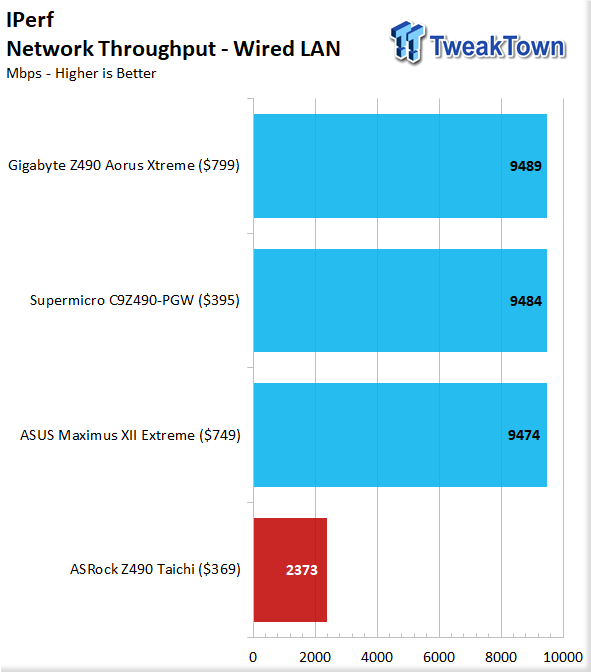
Here we see one area the Taichi is lacking, and that is the network interface. The other boards in the stack have a 10Gb network interface; the Taichi tops out with the 2.5Gb Rocket network controller. This is why while the other boards are pulling north of 9400Mbps, the Taichi tops at 2373Mbps.
Network testing: File transfer
The next part of network testing is a file transfer test. We use the same endpoint, but we are transferring data from the internal SanDisk Extreme Pro 1TB NVMe SSD.
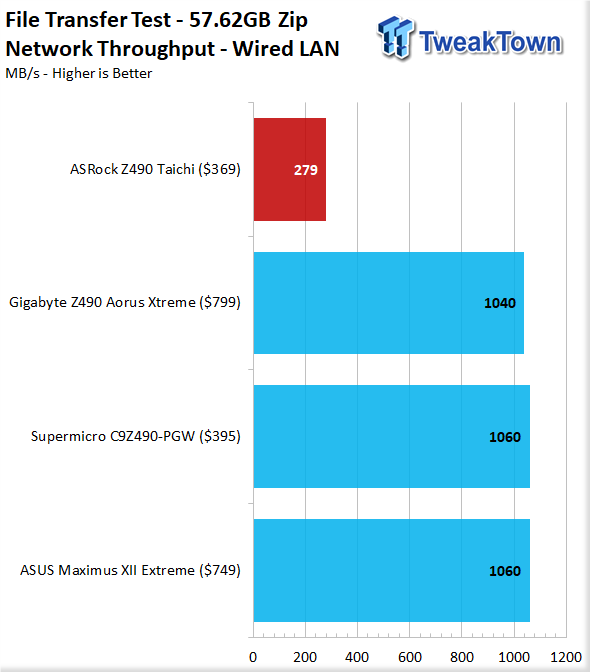
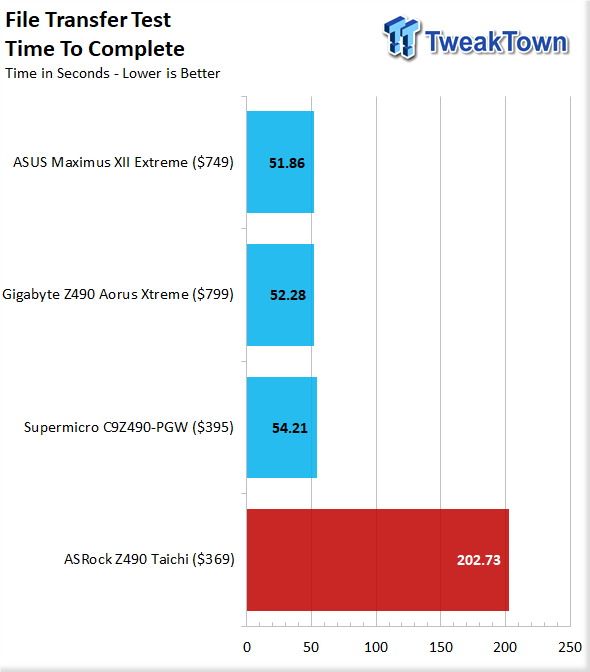
Here we see the file transfer test, which took a little over 202 seconds to complete, vs. the 10Gb equipped boards, which took just north of 50 seconds to complete. The total throughput we can see as well where the Taichi tops out at 279MB/s while the others move 1040 to 1060MB/s.
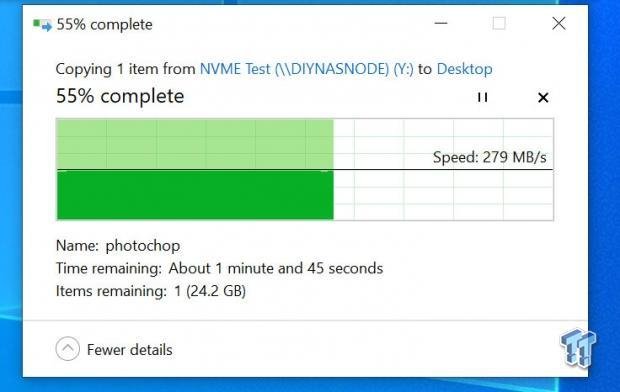
Here we see the actual throughput from windows reporting at an uninterrupted 279MB/s.
Clocks, Overclocking, Thermals, and Power Consumption
Here we will look at the physical and functional performance metrics for the new Z490 motherboards. This includes out of the box clocks, thermals, power consumption, and of course overclocking.
Out of the Box Clocks
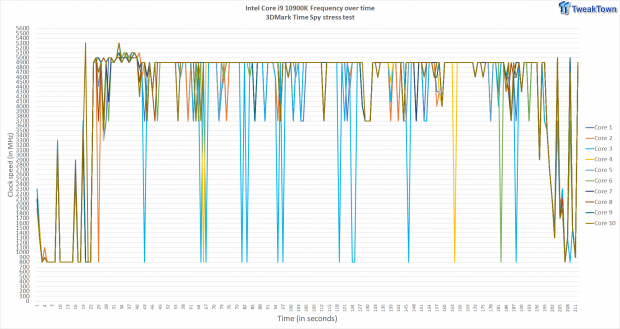
First up is a frequency plot for the 10900K on the Z490 Taichi. We can see that out of the box, the Taichi stays boosted long beyond the default intel guidance, which to be clear is ok. Intel has already confirmed that their guidance is the baseline for the processor. Still, motherboard manufacturers have constraints they must stay within to avoid triggering the OC flag. Therefore ASrock took this benefit to ensure their VRM is put to work by pushing the turbo constantly under load rather than clocking down after the default 56 seconds.
Power Consumption
For power consumption tests, we use a wall meter to test the full system draw. The reason for this is it will represent what the entire system pulls versus our meter, which shows power draw on each PSU cable. The reason for this is that measuring the power draw from the EPS cable, for example, does not take into account VRM losses and, therefore, can show a much higher power draw for the CPU or other device due to an inefficient VRM design or loading range.
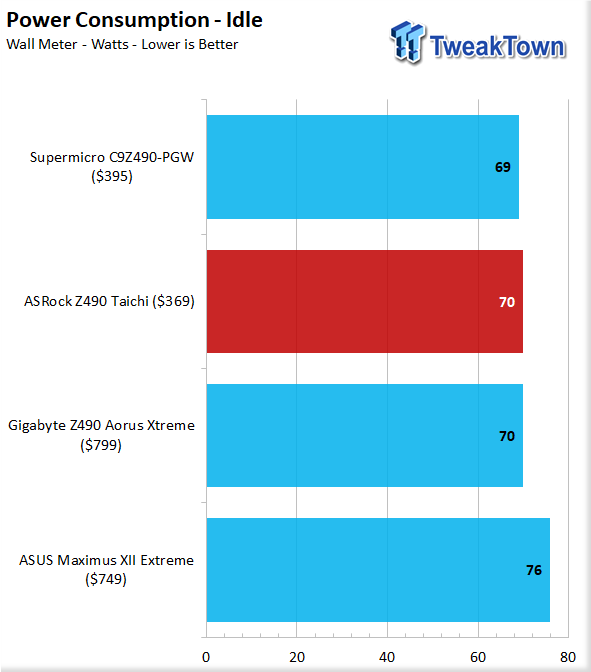
Idle power with the full system and TITAN RTX discrete GPU in place, we see the 10900K pulling 70W at idle, which is matched by the Aorus Xtreme. The Supermicro cuts the lead by one watt, while the Maximus with its bevy of features, OLED, RGB, and other EC's pulls an additional six watts.
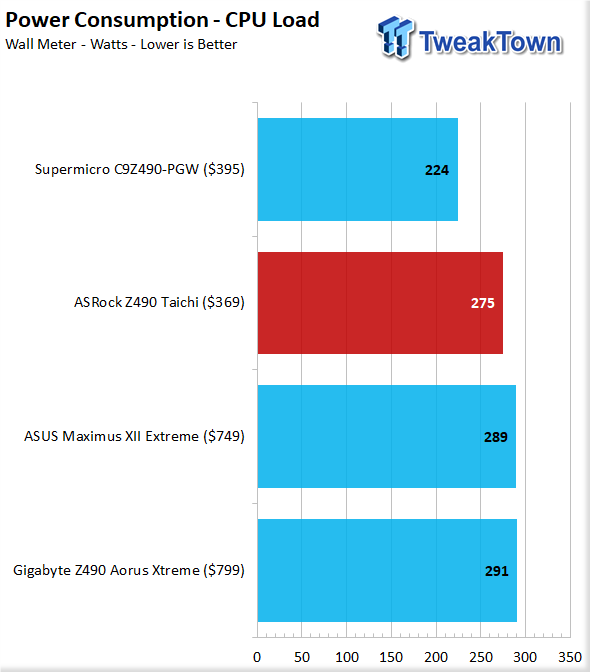
Loading up the CPU with a full FPU load, and the Supermicro holds a solid lead, but this is due to the time needed to reach steady state. By the time this is achieved under continuous loading, we see the turbo duration expire for the Supermicro board, which then drops power quite a bit. The Taichi at 275W is almost a solid 15 and 18 watts ahead of the two much more expensive models. This is likely caused by the extra features latched onto those boards.
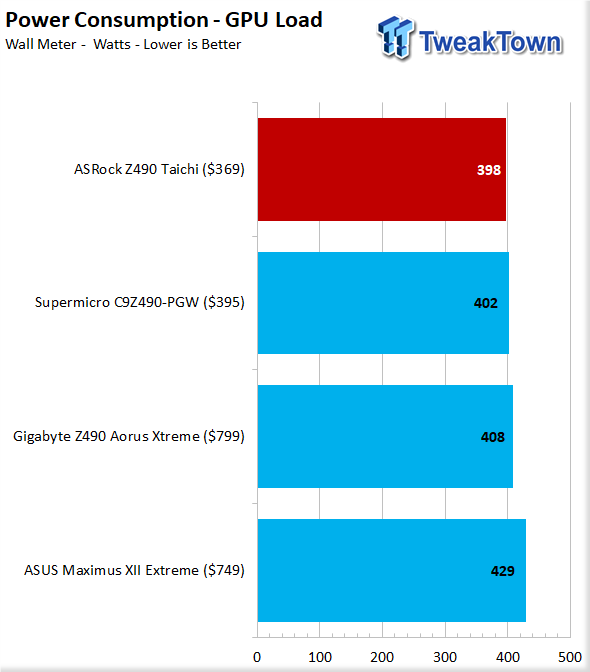
Testing synthetic GPU stress only is an excellent way to show the overhead the CPU adds, as the GPU does not pull more power after it reaches steady state. Here we see the Taichi lead the pack with the Supermicro trailing by four watts. The other more expensive boards trail a bit further with the Maximus Extreme showing the most significant pull at 429 watts, or over 30 watts more than the Taichi.
Thermals
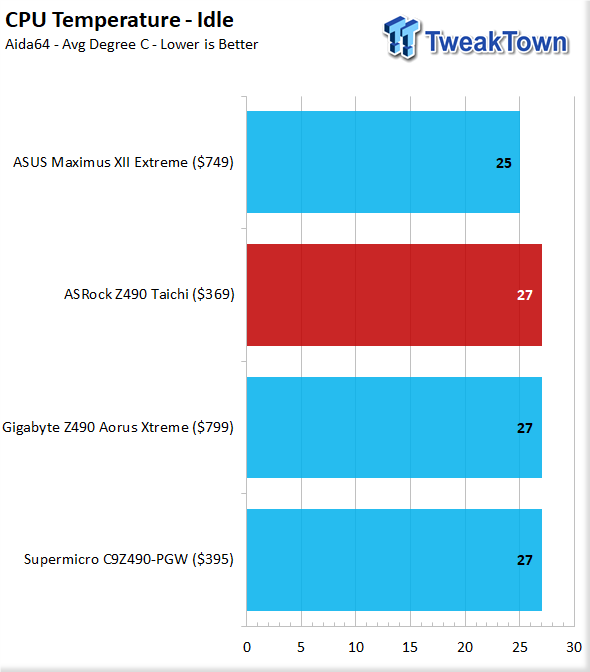
Idle temps for the 10900K in each board are almost a flat line, except for the Maximus Extreme, which seems to have throttled down more aggressively with the balanced power plan.
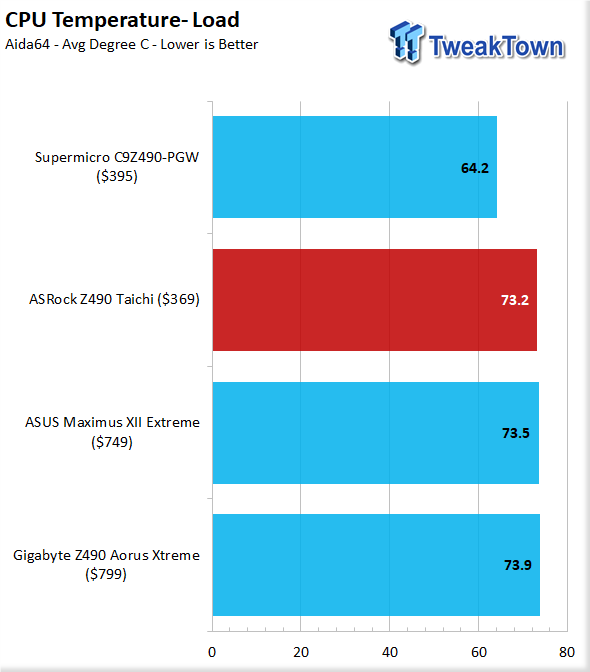
Loading each CPU up with a full burn-in FPU load, and we see all of the top-end boards fall in line with each other. Once again, the Supermicro benefits from its strict adherence to Intel guidance as it averages out to a package temp of 9C lesser than the other boards.
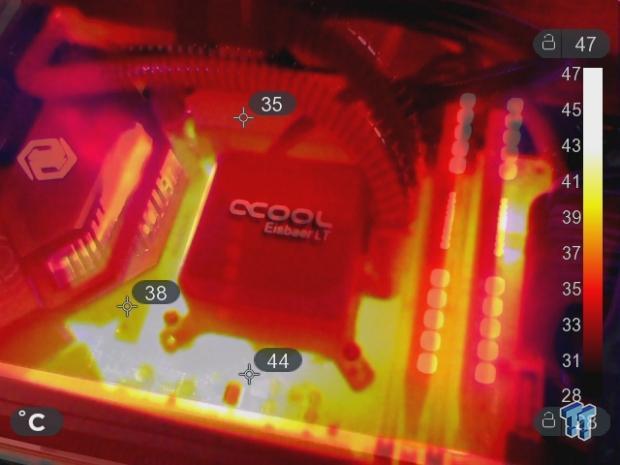
Here we see the Taichi under our thermal imager with a full load on the CPU for over an hour. As you can see, the VRM coolers surface does not exceed the 40C mark, which is fantastic and is mostly thanks to the chunky heat sinks and triple array of fans actively keeping thermals in check. It is worth noting that under even an overclocked load, the VRM heat sinks worked well enough without the fans running to stay under 80C on the power stages themselves, while the heat sink surface saw a top of 78C.
Overclocking
Overclocking with Comet Lake has been a lesson in limitations, both thermally and architecturally. As intel squeezes the 14nm node for all it has, the frequency is now under several boosting algorithms, which help enhance single or dual-core performance to the nth degree. However, it does not leave much on the table for overclocking.
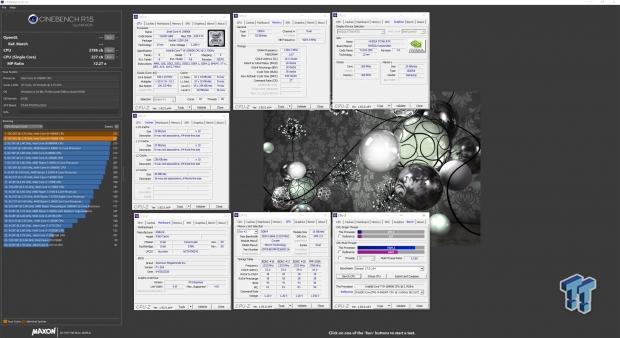
The Taichi was able to give us a reliable 5.2GHz all-core overclock. This is great for multi-threaded performance, but it does nudge the single-threaded performance down slightly as you now bypass the TVB, which boosts up to 5.3GHz.
Final Thoughts
The Taichi, when I first had it offered, was an exciting prospect based on the ASRock Taichi lineage of performance and optimizations. I felt like it was unfair to include it in the first round of benchmarks against boards double its value. However, ASrock and the Taichi proved my assumptions incorrect by muscling its way past the much higher cost boards in several tests.

What we like
Thermals: The Z490 Taichi may not be the highest featured board in the bunch. The ASRock engineering team went to work making sure the VRM could handle whatever you threw at it, and stay cool while doing so.
PCIe 4.0: While the PCIe 4 is not here, for Intel at least, we know that by the time it is, there will be even more GPUs and SSD's available that can utilize the faster interface.
Value: The Z490 Taichi has several of the right feature appointments to make it deserving of an enthusiast-class board at a much more palatable price point.
What do we think could be better?
SATA performance: The Taichi is a top performer in many respects, but the board I have on hand seems to run a fair bit slower via SATA than I would expect.
10Gb Network: The Taichi needs a 10Gb network as a flagship model. If ASRock hopes to match spec for spec or the best possible, the network needs a bump. This is more of a splitting hairs gripe, but even with the 10G NIC and traces added to the design/BOM, the cost difference to the consumer should be negligible.
The Z490 Taichi is something that I hope the ASRock team is proud of. It is a real competitor with the chops to take on boards far beyond its price range, and that's not something that can be easily dismissed.
Stay tuned as there are many more Intel Z490 motherboard reviews coming to TweakTown soon!

